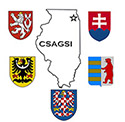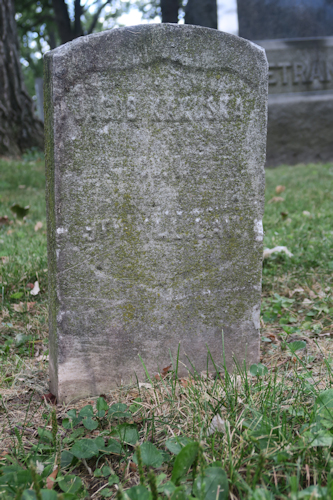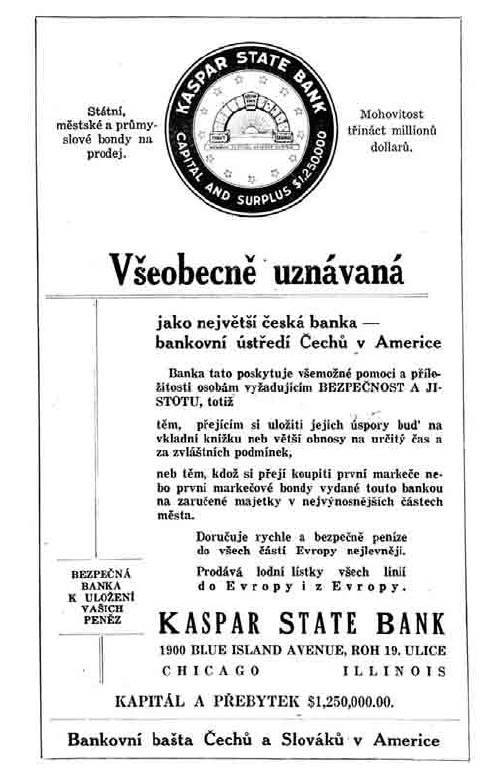Bohemian National Cemetery - The Civil War 18
Researching the 18 Civil War Veterans, buried in Bohemian National Cemetery, who are listed on the plaque alongside the BNC Civil War Memorial Monument
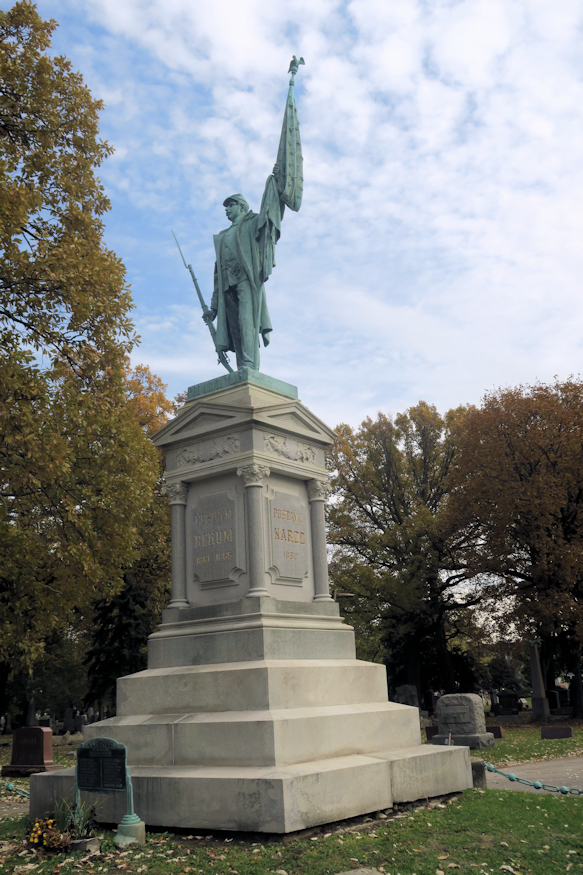
Bohemian National Cemetery - Civil War Commemorative Monument
On December 5, 1888, a committee, representing many Bohemian organizations, met to begin discussions to authorize the building of a monument to commemorate Czechs who served in the military. On July 28, 1889, thousands gathered for the laying of the cornerstone for the new monument. One of the names used to describe the monument was “Bohemian Soldiers and Sailors Monument”. The sculptor of the monument was Joseph Klir. On May 29, 1892, thousands again gathered and paraded to celebrate the unveiling of the new monument.[i]
The commemorative plaque listing the names of eighteen veterans as added in 1940.
While the plaque lists eighteen veterans of the Civil War, there are more veterans of that war buried in Bohemian National Cemetery.
This is an ongoing research project to discover information on each of the eighteen Czechs listed on the commemorative plaque. We welcome help in creating a better summary of each of these veterans.
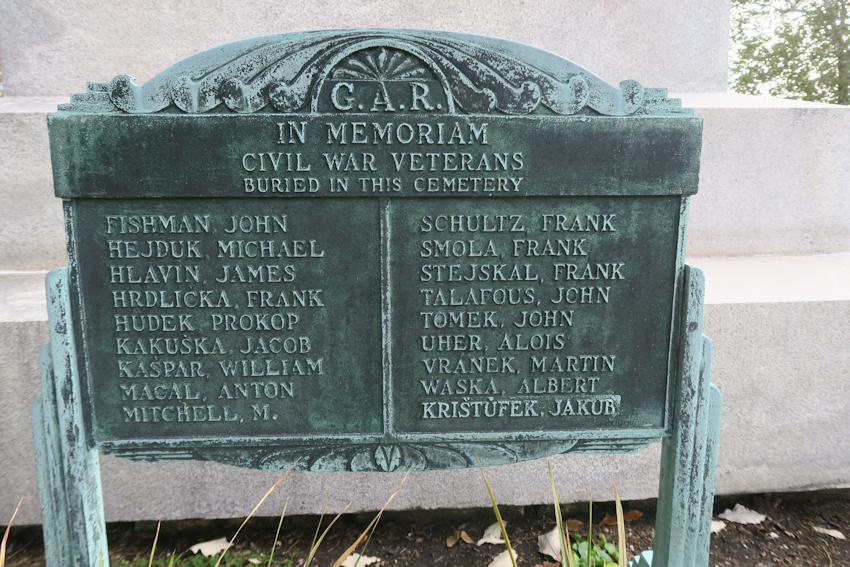
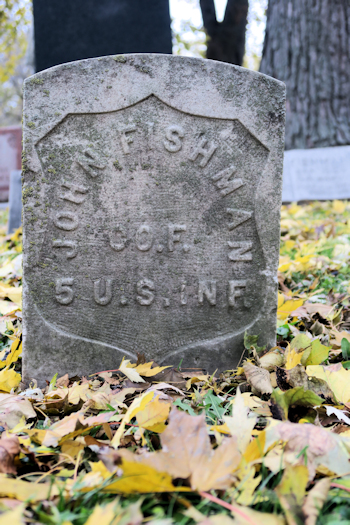
John Fishman
December 22, 1848 Moravia[i]
December 22, 1847 Frysava #25, (Frysava pod Zakovou) Moravia, Brno[ii]
July 19, 1915 Chicago
BNC Lot 116 Section 16
Pension Record: Lists Sergeant Company E 8th U.S. Infantry (Headstone Lists Company F 5th U.S. Infantry)
DH Obit: Jan Fishman 20, July, 1915
Find A Grave: # 149935348 and # 91734246 (two postings same person)
Military Headstone: Yes
Left Photo - Click Here Larger Image
Right Photo - Click Here Larger Image
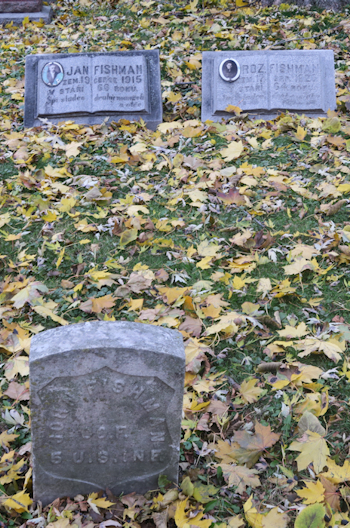

Jan Fishman obit published in the Denni Hlasatel on July 21, 1915.
Using Google Translate:
NOTIFICATION OF DEATH.
We communicate with the heart of pain to all friends and a mournful rumor that our dearly beloved husband died,
father, grandfather and brother,on Monday, July 19, 1915 at the age of 66 years and 7 months.
Dear deceased was born in Moravia, and 61 years in America. He was a member of the Tent of Czech Vysloužil with Spain-Amertcká
wars w. 30, U. S. Army and Navy Union and National Indian War Veterans. The funeral of the dear of the dead will be on Thursday at
10 am finished from the House of Sorrow 6. 2227 Already. Spauldlng ave. to national cemetery. - For quiet condolences:
THE FALLMAN FISHMAN, the Grieving Wife, Marie Poledna, Vtthe- Mill and Anna, Daughters, Frank, George, Harry, Edward and Martin
Stengl's sons, Frank Midday, son-in-law, Rozalle's granddaughter, AnnaHrejsa, Marie and Lulsie Ciskovsky, sisters and other friends.
Who would like to attend the funeral, kindly ask in the House of Sorrow or at the Graveyard Eduard 3. Hrejsa, 5137 Wed 25.
ul. Cioero 80. 80x2
Death Announcement.
All members of the Czech Choir. Amer. Voj. retired from War Spanish-American we announce that he died niceour honorary member,
JOHN FISHMAN, on Monday, July 19, 1915, 66 years old. After- the verdict of the deceased will quit on Thursday, 22. at 11 am from the House of Mourning Č.J227 Spauldlng ave. to the Czech-National Cemetery. The survivors show-my sincere condolences. Members are asked toThe funeral was eventually made in uniform and gatheredin the Vojta Náprstek School Hall on Homan avewill be out at 10:30 am.
FOR THE CHRIST. AMÉR. VYSL. FROM WAR SPAIN-AMER. Josef Bltson, commander. Ctibor Haller, Secretary.

There is only one John Fishman (or Fischmann or any other closely related spelling) listed in the BNC Death Index, as buried in the cemetery. Currently this writer views this John Fishman as suspect to be an actual veteran of the Civil War, rather having entered military service at a later date. There exists an enrollment record for 1866, the year after the war for John Fishman, age 18, but no other Civil War registry lists a John (Jan) Fishman with a similar birthday. [i] This John Fishman would have only been thirteen or fourteen at the start of the Civil War. There always exists the possibility that the birth dates have not been recorded properly, but his actual birth record is December 22, 1847.
Click Here To View John Fishman Frysava #25 Birth Record Click Here To View John Fishman Pension Record Click Here To View A Second John Fishman Pension Record
Family Search does list this John Fishman as a member of the 5th US Infantry, but no other Civil War year dates (NPS Soldiers and Sailors Database, Cyberdrive Illinois Civil War Databases) are associated with this record. [ii] There is a 5th US Infantry Regiment. It spent the Civil War years in New Mexico and Kansas. No list of soldiers for that time period seems to be available online. There are two (Fold3) documented pension records for John Fishman, who died July 19, 1915, as enlisting May 5, 1874 and ending service on March 4, 1886 for B and E (two pension records for different reporting periods) Company of the 8th US Infantry. Both pension records list Chicago and mention “Indian War Widow”[iii]
Only two people are buried in Lot 116, Section 16, John and his wife, Rosalie Vales Stangle. John married Rose in 1888.
John, age 6, father, Johann , (Find a Grave # 194539198) age 35, mother, Anna (Zeleny), a (Find a Grave # 194539175) age 29, arrived from port Bremen to port New York City on June 6, 1854, aboard the ship Juno. Their name was spelled Fischmann. [iv]
Paul Nemecek, in his Koreny article of September 2004, "Early Bohemian Settlers in Chicago", lists a John Fishman as arriving in 1854. John is listed in the 1860 Illinois Census living with his parents and sister, Anna, age 2, born in Illinois, under the spelling of Fisharm.[v] If the information on his actual first enlistment in the military in 1866 is correct, then the remainder of military records indicate his continued series of enlistments following that through the next two decades. While records of his parents and siblings continue to be found as they lived in Chicago, John’s next verified record is after his father died in 1879. The 1887 Chicago Directory lists Ann Fishman, widow of John, living at 446 Jefferson and the listing below is John Fishman, also at 446 Jefferson.[vi]
The 1900 and 1910 census list John as a fireman. The 1910 census records that Rose had nine children, including son Martin Stangle, from her first marriage. Eight children were surviving in 1910.
[i] Ancestry.com. U.S. Army, Register of Enlistments, 1798-1914 [database on-line]. Provo, UT, USA: Ancestry.com Operations Inc, 2007. Record Page 275.
[ii] "Illinois Soldier Burial Places, 1774-1974," database, FamilySearch (https://familysearch.org/ark:/61903/1:1:QVY9-7V37 : 16 March 2018), John Fishman, ; citing Burial, , Cook, Illinois, United States, Bohemian Nat'l Cemetery, Illinois State Archives, Springfield; FHL microfilm 1,001,205.
[iii] www.fold3.com - Civil War Pensions Index › ... United States › Infantry › Regiment 8 › Company E › Fishman, John
[iv] Ancestry.com. New York, Passenger and Crew Lists (including Castle Garden and Ellis Island), 1820-1957 [database on-line]. Provo, UT, USA: Ancestry.com Operations, Inc., 2010.
[v] Year: 1860; Census Place: Chicago Ward 10, Cook, Illinois; Roll: M653_168; Page: 555; Family History Library Film: 803168
[vi] Ancestry.com. U.S. City Directories, 1822-1995 [database on-line]. Provo, UT, USA: Ancestry.com Operations, Inc., 2011.
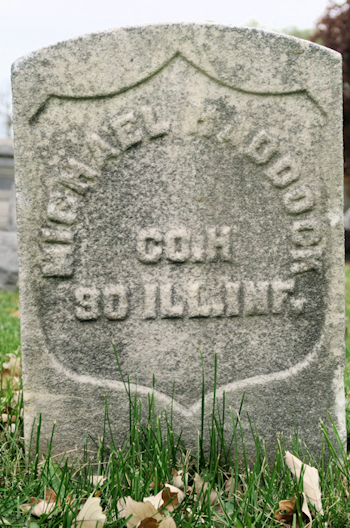
Michael Hejduk
Michael Haddock (nearly all records use this alias)
January 14, 1844 Bohemia
October 22,1936 Chicago
BNC Lot 3 Block 6 Section B
Mustered In: Chicago August 16, 1862. Mustered Out: June 6, 1865
Listed as Michael Haduk
Pension: Company H, 90th Illinois Infantry
DH Obit: Michael Haddock 23,October,1936
Find A Grave: Two listings: # 95111828 and # 139029756
Military Headstone: Yes
Left Photo - Click Here For Larger Image
Right Photo - Click Here For Larger Image
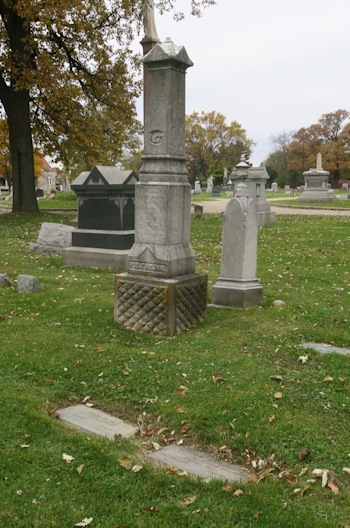
Much of the information for Michael Hejduk, Haddock, is based on information gathered by, and used with the permission of Nancy Brake, great grandniece of Michael Hejduk. Nancy explained that the last name was changed, and most records used the change, as a result of Haddock being the spelling used on his enlistment records.
The Chicago Daily Tribune, October 23, 1936 obituary for Michael Haddock listed Haddock: “Michael Haddock, civil war veteran, a resident of Berwyn for the last 23 years, died yesterday at his home, 6444 West 26th Street, in the suburb, where he lived with a niece, Mrs. Mary Smidl. He was 94 years old. Mr. Haddock was born in Bohemia and came to the United States at the age of 8. His service in the war was with the army of Gen. W.T. Sherman. Funeral services will be held at 2 p.m. today from the chapel at Roosevelt road and Genderson street. Burial will be in the Bohemian National Cemetery. Military observances will be held at the grave by the Berwyn post of the Veterans of Foreign Wars of which Mr. Haddock was an honorary member.”[i]
The Bubinecek book mentions that father Frantisek Hejduk was in Chicago by 1853, from Mirotice, and he died in 1855. Wife Marie lived in Chicago. Son Matej Hejduk fought in the Civil War.[ii]
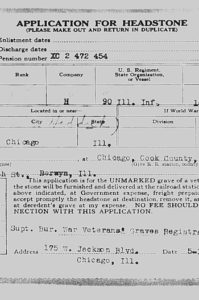 Michael Hejduk became Michael Haddock when he became part of the 90th Illinois Infantry. They were nicknamed the “Irish Legion”[iii] Nancy Brake explains that it was changed at the time of enlistment. Michael Hejduk Haddock began his enlistment on September 7, 1862 and was mustered out on June 10, 1865. Nancy’s family history indicates that the 90th Illinois trained at Camp Douglas in Chicago, which would also be holding Confederate prisoners. The 90th assembled in Cairo and from there participated in campaigns in: Vicksburg, Mississippi; Tennessee and participated in Sherman’s March to the Sea. Michael endured a bout of typhoid fever and was wounded twice in the legs.[iv]
Michael Hejduk became Michael Haddock when he became part of the 90th Illinois Infantry. They were nicknamed the “Irish Legion”[iii] Nancy Brake explains that it was changed at the time of enlistment. Michael Hejduk Haddock began his enlistment on September 7, 1862 and was mustered out on June 10, 1865. Nancy’s family history indicates that the 90th Illinois trained at Camp Douglas in Chicago, which would also be holding Confederate prisoners. The 90th assembled in Cairo and from there participated in campaigns in: Vicksburg, Mississippi; Tennessee and participated in Sherman’s March to the Sea. Michael endured a bout of typhoid fever and was wounded twice in the legs.[iv]
The Adjutant General of Illinois published a series of books on the Regiments and Units of the Civil War. This is the history of the 90th Illinois Infantry. It lists Michael as Haduk among its various published records.
The Chicago Directory of 1867 listed Michael Haddock as a laborer living at 71 Ewing. His brother Frank was listed as a tinner at the same address.
Verified records for Michael Hejduk (Haddock) have been elusive. The 1920 and 1930 census list Michael as living with his niece, the James and Marie Smidl family. Both census records list Michael as uncle, and widowed.
Berwyn Life October 23, 1936 "RITES TOMORROW Fought jn Sherman's Army for Four Years 'Michael Haddock, 94, 6444 West 26th street, the only surviving local Bohemian who served in the Civil war over 75 years ago, died yesterday morning of old age after a cold aggravated a weak heart condition. An honorary member of Berwyn Post No. 2378, Veterans of Foreign Wars, Haddock served under General William Sherman during the entire war. He entered the regular army of the United States at the outbreak '"of hostilities in 1861 when 19 years old and saw action in Shermans epochal march to the sea, and in the historical battles of Missionary Ridge, Fort McAllister, the battle of Vicksburg and others. On one occasion Haddock was offered a captaincy in the army after he had imperiled his life to save the colors of the unit in which he was serving. He refused the honor, however, because he felt himself too young to command other soldiers. He will be buried tomorrow afternoon at two oclock from Mariks Undertaking chapel with interment at the Bohemian National cemetery. Fellow members of the Berwyn veteran post will probably be active pallbearers and will par-ticipate in the funeral services at the chapel and in the cemetery. He is survived by five nieces, Mrs. Mary Smldl, with Whom he lived, and Anna Miller of Oak Park, Mrs. Caroline Fiala of Brookfield, Mrs. Mayme Hronik and Ella Wehrs, and a nephew, George Haydock of Cicero. Mr. Haddock had hever married."
[i] Chicago Daily Tribune; Chicago, Ill. [Chicago, Ill] 23 Oct 1936: 34.
[ii] A history of the Czechs in Chicago, Collected and Organized by Rudolf Bubenicek. Translated by Karleen Chott Sheppard CSAGSI, Chicago, Illinois, 1939. Privately printed. Typesetting by West Side Press. Printed and bound by R. Mejdrich and Company.
[iii] https://civilwar.illinoisgenweb.org/reg_html/090_reg.html
[iv] Historical summary of Matej Hedjuk provided by, and used with permission of, Nancy Brake.
James /Vaclav /Wenzel Hlavin
1825 Bohemia
May 11, 1893 Chicago
BNC Lot 7 Block 1 Section G
Military Unit: None Found
Pension Record: None Found
DH Obit: None Found
Find A Grave # 95111766
Military Headstone: No
James Hlavin remains a mystery. There are no Hlavan, nor Hlaven surnames listed in the BNC Death Index. There are two James / Wenzel / Vaclav Hlavin listed. One James Hlavin died in 1932, but was born in approximately 1866. The other, Vaclav, was born in 1825 and died in 1893.
The Vaclav Hlavin, born in 1825 and dying in 1893, is listed only in Family Search as an Illinois soldier.[i] I visited BNC Lot 7 Block 1 Section G, just once, and was not successful in finding a headstone for Vaclav / James / Wenzel Hlavin. There is no record of a military headstone request placed for Vaclav.[ii] Vaclav is buried in the grave site with his wife Catherine.
The only, even apparently close name discovered is James Hlawritg. Family Search does not have that name appearing anywhere. But the Illinois Database of Illinois Veterans Index does list James Hlawritg, age 41, serving in the Civil War as an Illinois soldier from 1864 to 1865.[iii] That is also the only Ancestry listing for Hlawritg. Vaclav Hlavin is listed on the Roll of Honor, Burials Bohemian National Cemetery published in 1922. But, just a name is given, no other information was posted, not even a death date. The actual book “Roll of Honor” lists Vaclav Hlavin as buried in Lot 7 Block 1 Section G.[iv]
No record for a veteran’s pension has been found. A search of the Civil War and Later Pension Index does not list either, or closely spelled, matches for either.
The 1880 census record for Vaclav, Catherine, and their children, list children; Joseph, age 20 James age 14, Frank age 8, all born in Bohemia, and Mari, age 3, born in Illinois. If this record is correct, son Frank, would have been born in Bohemia in 1872.[v]
Wenzel Hlavin (age 47), Catherine, and children; Anna, Joseph, Wenzel and Franz (age 6/12) arrived from port Bremen to port Baltimore on November 11, 1872 aboard the ship Leipzig.[vi]
Vaclav’s death address of 219 Henry in May of 1893, is confirmed with the 1900 Chicago Directory address of: Hlavin, Catherine Widow 219 W. 14th Place. 14th Place was previously called Henry Street. Ancestry, in its Illinois Wills and Probate records supports that date.
The 1875, 1882, 1888, and 1892 Chicago Directories list Vaclav as a gardener or a florist.
[i] "Illinois Soldier Burial Places, 1774-1974," database, FamilySearch (https://familysearch.org/ark:/61903/1:1:QVY9-W9YF : 16 March 2018), Vaclav Hlavin, ; citing Burial, , Cook, Illinois, United States, Bohemian-National Cemetery, Illinois State Archives, Springfield; FHL microfilm 1,001,206.
[ii] "United States Records of Headstones of Deceased Union Veterans, 1879-1903," database with images, FamilySearch (https://familysearch.org/ark:/61903/3:2:77TD-VGQ7?cc=1913388&wc=MXM9-TNP%3A195534201 : 22 May 2014), Higgs, James - Jaynes, John W. > image 125 of 859; citing NARA microfilm publication M1845 (Washington, D.C.: National Archives and Records Administration, n.d.).
[iii] Ancestry.com. Web: Illinois, Databases of Illinois Veterans Index, 1775-1995 [database on-line]. Provo, UT, USA: Ancestry.com Operations, Inc., 2015.
Original data: Databases of Illinois Veterans. Illinois State Archive. http://cyberdriveillinois.com/departments/archives/databases/home.html: accessed 5 August 2014.
[iv] Roll of Honor, Published by the Honorable Board of Commissioners of Cook County, Illinois, 1922, Page 194.
[v] Year: 1880; Census Place: Chicago, Cook, Illinois; Roll: 190; Page: 168A; Enumeration District: 070
[vi] The National Archives at Washington, D.C.; Washington, D.C.; Records of the US Customs Service, RG36; NAI Number: 2655153; Record Group Title: Records of the Immigration and Naturalization Service, 1787-2004; Record Group Number: 85
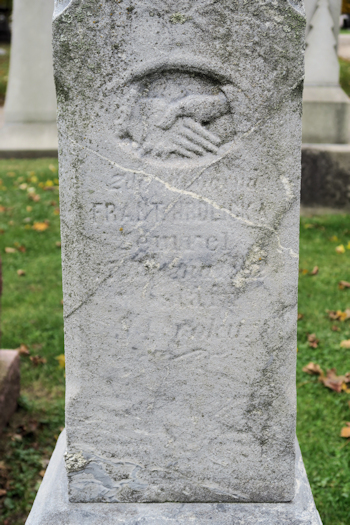
Frank Hrdlicka
November 29, 1847 Vodnany #164, Bohemia
March 17,1882 Chicago
Lot 8 Block 2 Section D
Pvt. B Company 7th Wisconsin Infantry
Enlisted February 27, 1865 Mustered Out July 3, 1865
Pension Frank Hrdlicka Pvt. B Company 7th Wisconsin Infantry
DH Obit: No
Find A Grave #214577018
Military Headstone: No
Left Photo - Click Here For Larger Image
Right Photo - Click Here For Larger Image
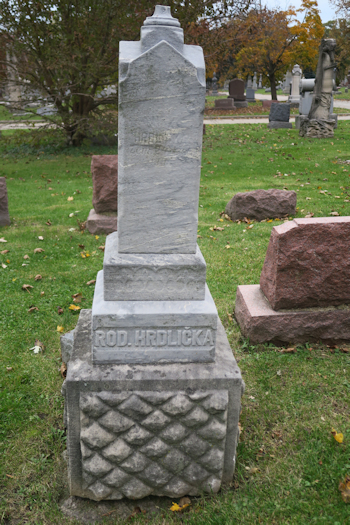
Frank Hrdlicka was born on November 29, 1847 at Vodnany #164 to Wenzel Hrdlicka and Catharina Zeleny. (Click Here To View Image Of Birth Record) Frank’s brother, Vaclav, was born around 1855 in Canada, so it is assumed that they arrived around that time in North America. Organized in 1861, the 7th Wisconsin Infantry was involved in significant battles including the Second Bull Run and Gettysburg. A monument for their unit was placed at Gettysburg. (http://gettysburg.stonesentinels.com/union-monuments/wisconsin/7th-wisconsin/) Frank Hrdlicka only served for a few months during the period of the Civil War, before the war ended and his unit was mustered out in Kentucky.[i]
Frank, his parents and siblings, are listed in the 1860 and 1870 census records for Cooperstown, Manitowoc County, Wisconsin. Frank Hrdlicka married Anna Suchan on January 23, 1870 in Manitowoc County, Wisconsin. Frank, wife Anna, and children are listed on the 1880 Census for Cooperstown.
Frank’s father died in 1871 in Cooperstown. Sometime after that, Frank, his mother, and his siblings would eventually reach Chicago.
The Bubinicek book lists Frank Fucik and Frank Hrdlicka as co-owners of a tavern on Fisk Street.[ii]
Frank’s time in Chicago was short, dying in 1882. Frank’s wife is listed in the 1882 Chicago Directory as a widow, living at the address listed on Frank’s death.[iii] Fold3 and Ancestry has a 1908 record of Frank’s wife continuing to receive a widower’s pension. There is no discovered record of an application for a military headstone for Frank. Rather a family headstone is located in Lot 8, Block 2, Section D.
Note: Also buried in Bohemian National Cemetery in Lot 17 Block 4 Section D is Adolph Chladek (1838 – 5-13-1887). Adolph is a Civil War veteran, like many others, not listed on the plaque. Adolph, like Frank Hrdlicka, was also from Manitowoc County, Wisconsin. He served in Company B or the 9th Wisconsin Infantry and was mustered out as a second lieutenant.
[i] http://civilwarintheeast.com/us-regiments-batteries/wisconsin/7th-wisconsin/
[ii] A history of the Czechs in Chicago, Collected and Organized by Rudolf Bubenicek. Translated by Karleen Chott Sheppard CSAGSI, Chicago, Illinois, 1939. Privately printed. Typesetting by West Side Press. Printed and bound by R. Mejdrich and Company. Page 156.
[iii] Illinois, Chicago, 1882, Chicago, Illinois, City Directory, 1882
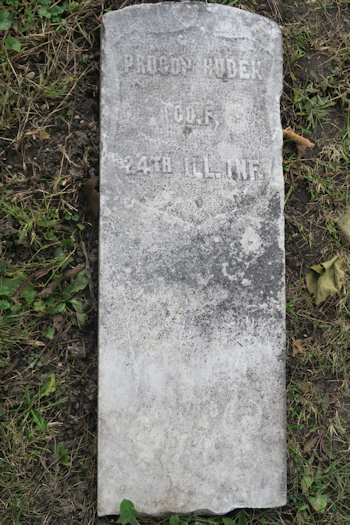
Prokop Hudek
July 9, 1843 Nova Ves #11, Uhlirkse Janovice, Kutna Hora
February 25, 1886 Chicago
Lot 8 Block 4 Section M
Captain Company F 24th Illinois Infantry “Lincoln Rifles”
Mustered in, as Private, on July 8, 1861. Mustered Out, as Captain, on August 6, 1864.
Pension Company F 24th Illinois Infantry
DH Obit: No
Find A Grave # 23355293
Military Headstone: Yes
Left Photo - Click Here For Larger Image
Right Photo - Click Here For Larger Image

Chicago Tribune – February 2, 1886 – “Prokop Hudek, the well-known politician and real estate dealer of the Sixth Ward, died at his residence, No. 459 West Eighteenth Street at 5 o’clock yesterday morning, after an illness of five weeks. He was suffering from liver complain and dropsy and his death had been expected for the last week. He leaves a wife and one child, and his funeral will take place 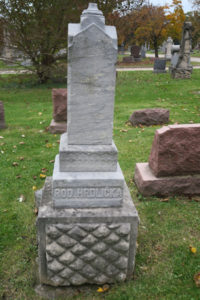 Sunday at 10 o’clock from his late residence to the Bohemian National Cemetery. He was popular among his countrymen as was well known by a large number of Americans. Mr. Hudek was born in Bohemia in 1843, and is now 42 years old. He came to New York when he was 12 years old and learned the saddler’s trade. During all his life he worked for his countrymen with energetic zeal to get them naturalized. In 1861 the the first shot was fired on Fort Sumter, and when Gov. Yates called for volunteers, Hudek was among the first to respond, joining a Bohemian company. After his term was served in this company he enlisted again in the Twenty-fourth Illinois Infantry for three years, being then but 18 years old. He was with Sherman on his march to the sea. He had lived in Chicago for thirty years, dealing in real estate and fire insurance. He was one of the parties who originated the building and loan associations, the first one being called Building & Loan Association No. 1. This was in 1873, and in 1882 he was secretary and notary of six of those associations. He was also a fluent speaker in several languages. He was Captain of the Bohemian Lincoln Rifles and a member of Bohemia Lodge, and C.S.P.S., No. 65. These lodges will attend
Sunday at 10 o’clock from his late residence to the Bohemian National Cemetery. He was popular among his countrymen as was well known by a large number of Americans. Mr. Hudek was born in Bohemia in 1843, and is now 42 years old. He came to New York when he was 12 years old and learned the saddler’s trade. During all his life he worked for his countrymen with energetic zeal to get them naturalized. In 1861 the the first shot was fired on Fort Sumter, and when Gov. Yates called for volunteers, Hudek was among the first to respond, joining a Bohemian company. After his term was served in this company he enlisted again in the Twenty-fourth Illinois Infantry for three years, being then but 18 years old. He was with Sherman on his march to the sea. He had lived in Chicago for thirty years, dealing in real estate and fire insurance. He was one of the parties who originated the building and loan associations, the first one being called Building & Loan Association No. 1. This was in 1873, and in 1882 he was secretary and notary of six of those associations. He was also a fluent speaker in several languages. He was Captain of the Bohemian Lincoln Rifles and a member of Bohemia Lodge, and C.S.P.S., No. 65. These lodges will attend the funeral. As to his political career he was a staunch Republican. At one time he became a hot-headed Socialist. This was about 1879, and was the Socialists’ candidate for Alderman opposing Fred Lodding, the German candidate. After a big fight, he was defeated. He was never an extremist. He was a strong supporter of Blaine and Logan and Garfield, and worked hard for that party. He also ran for State Senator in 1880 or thereabouts.”
the funeral. As to his political career he was a staunch Republican. At one time he became a hot-headed Socialist. This was about 1879, and was the Socialists’ candidate for Alderman opposing Fred Lodding, the German candidate. After a big fight, he was defeated. He was never an extremist. He was a strong supporter of Blaine and Logan and Garfield, and worked hard for that party. He also ran for State Senator in 1880 or thereabouts.”
Born, July 9, 1843 in Nova Ves, (Click Here To View His Birth Record) Prokop, his parents, Frank and Anna, and siblings Anna and Therese, depart port Hamburg on November 22, 1855 (under spelling Kudek) and arrived at port New York on December 32, 1855 (under spelling Kudick) aboard the ship Elida.
First, part of the Slavonic Company on October 16, 1860, then reorganized by April 1861, under the name of Lincoln Rifles, they were attached in Alton, Illinois to the 24th Regiment under the command of Hecker. Before the unit was reorganized, Prokop had been given the rank of captain. The regiment was mustered out August 6, 1864 in Georgia. The 24th Infantry Regiment was the first Chicago area military unit to return to Chicago.
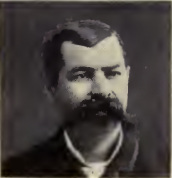 Rudolf Bubenicek, in his book, describes that Alois Uher, Frank Smola, Prokop Hudek and Jan Talafous (all named on the monument plaque), signed up to join the Slavonic Company on 1, 1861 while gathered at Anton Mach’s tavern, which was located at the corner of Canal and Randolph Streets.[i] While actually enlisted in Chicago, the unit began its military history after arriving in Alton, Illinois. Most campaign activities were in the states of Kentucky and Tennessee, with participation in the Battle of Chickamauga and Sherman’s campaign in Georgia, perhaps the most notable.
Rudolf Bubenicek, in his book, describes that Alois Uher, Frank Smola, Prokop Hudek and Jan Talafous (all named on the monument plaque), signed up to join the Slavonic Company on 1, 1861 while gathered at Anton Mach’s tavern, which was located at the corner of Canal and Randolph Streets.[i] While actually enlisted in Chicago, the unit began its military history after arriving in Alton, Illinois. Most campaign activities were in the states of Kentucky and Tennessee, with participation in the Battle of Chickamauga and Sherman’s campaign in Georgia, perhaps the most notable.
Five of the eighteen veterans listed on the Civil War Plaque were members of the 24th Illinois Infantry. Prokop Hudek, Frank Smola, John Talafous and Alois Uher were in Company F. Matthew Mitchell was in Company B. The Illinois Adjuntant General's Report on Regiment and Unit Histories 1861 - 1865, published in 1900, has a very good summary of the 24th Infantry's actions in the Civil War. All five of these veterans are also listed in the book as members of the unit. PDF file describing the 24th Infantry's actions in the Civil War. View Roster of 24th Illinois Infantry From Illinois Adjutant General's Regiment and Unit Histories 1861 - 1866
Bubinicek, page 255 “Cesko Narodni Podpurny Sbor (Czech National Protective Society) as founded on August 21, 1872 on the northwest side of Chicago by Prokip Hudek, known to us as a captain in the Civil War and a diligent worker in social life. The society had as its purpose paying out to its members insurance for illness and a death benefit. The first officers of the Society were chairman Prokop Hudek, vice-chairman Vojtech Hana, treasuerer Frantisek Dvorak, financial secretary Jan Vrba and secretary Vaclav Straka.”
 Prokop Hudek married Apolena Dvorak, in Chicago, on October 1, 1883. Hudek was very actively involved. He was a founding member of the Bohemian National Cemetery Association, working to create the Bohemian National Cemetery as a corporation in order to buy land. Prokop finalized this on April 11, 1877 in Springfield. Hudek was also a founding member of Saint Procopius Catholic Church in Chicago.[ii]
Prokop Hudek married Apolena Dvorak, in Chicago, on October 1, 1883. Hudek was very actively involved. He was a founding member of the Bohemian National Cemetery Association, working to create the Bohemian National Cemetery as a corporation in order to buy land. Prokop finalized this on April 11, 1877 in Springfield. Hudek was also a founding member of Saint Procopius Catholic Church in Chicago.[ii]
The archives of the Chicago Tribune have a number of articles related to Prokop Hudek, as participating in a number of activities, including promoting Czech participation in Chicago, and supporting activities to have the Chicago Public Library procure books related to Czech history and culture in the Czech language.
Click Here - 1891 Newspaper Article - Prokop Hudek participating in Lincoln Remembrances at BNC
[i] Bubenicek, Rudolf: A history of Czechs in Chicago. Translated by the Czech and Slovak Genealogy Society of Illinois. 2011. Pages 61-62.
[ii] A history of the Czechs in Chicago, Collected and Organized by Rudolf Bubenicek. Translated by Karleen Chott Sheppard CSAGSI, Chicago, Illinois, 1939. Privately printed. Typesetting by West Side Press. Printed and bound by R. Mejdrich and Company. Page 329.
Jakub Kakuska (Kashkushka)
April 25, 1845 Bohemia
October 15, 1880 Chicago
Lot 14 Block 5 Section S
Private Company I 9th Regiment Illinois Cavalry Mustered in October 3, 1864, Mustered out October 13, 1865
Pension: 9th Regiment Illinois Cavalry
DH Obit: No
Find A Grave: # 5099832
Military Headstone: Yes
 Chicago Tribune – October 16, 1880 “An accident most horrible in its every detail took place at 7 o’clock last evening in the Garden City Distiller of Simon Powell & Sons, situated in a triangular tract of land at the intersections of Twenty-second and Morgan streets and Canalport avenue…..it was found that the engine-room, boiler-room, and a large shaving bin, situated….were completely demolished. Jacob Kakuska, the engineer, was formerly a Constable. He was a well-known citizen and petty politician, and left a wife and three children in fair circumstances at No. 412 West Eighteenth Street. He was of Bohemian descent, and about 36 years of age…….”
Chicago Tribune – October 16, 1880 “An accident most horrible in its every detail took place at 7 o’clock last evening in the Garden City Distiller of Simon Powell & Sons, situated in a triangular tract of land at the intersections of Twenty-second and Morgan streets and Canalport avenue…..it was found that the engine-room, boiler-room, and a large shaving bin, situated….were completely demolished. Jacob Kakuska, the engineer, was formerly a Constable. He was a well-known citizen and petty politician, and left a wife and three children in fair circumstances at No. 412 West Eighteenth Street. He was of Bohemian descent, and about 36 years of age…….”
Jakub Kakuska, age 8, arrived from port Liverpool to port New York City on April 3, 1854, aboard the ship Albert Gallatin. Jakub arrived with parents; Bartola 44, Terese 40, Anton 12, Jolena (Spelling??) 4 and Maria, age 6. They were listed under the spelling of Yakutschka. The March 2009, Koreny article on Jakub and his family described how his family reached Chicago and faced numerous hardships in the early years after their arrival. [i] Jacob’s parents, Bartholomew and Theresa are also buried in Bohemian National Cemetery.
The 9th Regiment had been organized in the fall of 1861. They were first encamped at Camp Douglas in Chicago and engaged in military campaigns beginning in February 1862 in Arkansas and later in Tennessee. Jakub Kakuska enlisted in the 9th Regiment of Illinois Cavalry on October 3, 1864 in Chicago, and was mustered out on October 31, 1865 in Montgomery, Alabama.[ii] Thanks to the person helping me, Nancy Brake, she provided information that another Czech, Matthies Skoblik (spelling used in the “History of the Ninth Illinois Cavalry”) joined with Jakub at the same time and was mustered out at the same time. Matthies appears to have gone to Minnesota after the war.
Volume Eight of the Illinois Adjutant General’s Report of Illinois Regimental and Unit Histories 1861 – 1866, published in 1900 has on page 192 the listing for Jacob Kakuska as Kashkushka, Chicago, Enrolled 10-3-1864, Mustered in 10-3-1864 and Mustered out 10-13-1865.
Pages 209 to 211 provide a summary of this Illinois unit: “The Ninth Regiment of Cavalry was organized at Camp Douglas, near Chicago, Illinois, in the autumn of 1861, by Colonel Albert G. Brackett, and was mustered into the United States service by November 30.On the 16th of February. 1SG2, it started from Chicago and proceeded by rail to Benton Barracks, near St. Louis, Missouri, and thence to Pilot Knob. From there it marched to Reeve's Station, on the Big Black River, and was assigned to the Third Brigade of General Steele's Division, serving in the District of Southeast Missouri…….
In January, 1864, the Regiment was in the Second Brigade, commanded by Colonel
Albert G. Brackett, of Grierson's Division, Sixteenth Corps, Army of Tennessee, at Collierville, and detachment under Major Ira Gilford had a brisk skirmish with a portion of Forrest's command, which had made an attack upon the Memphis and Charleston railroad, in which several of the enemy were killed and wounded. February 11, 1864, the Regiment moved out by order of General Sherman against the enemy, with the Union force organized under General William Smith, Chief of Cavalry of the Division of the Mississippi, with a view to overthrow the rebel cavalry under General Forrest. He pushed across the country as rapidly as possible…….Although the chief object of the expedition was not accomplished, the cavalry had inflicted heavy injuries upon the Confederates. On the 16th of March the Regiment was mustered as a veteran organization, and the following day marched to Memphis, whence the men returned to Illinois, on the usual furlough granted to veterans: April 27, the men of the Regiment returned to Memphis from furlough, and a short time thereafter a portion of them accompanied General Sturgis on his expedition against the enemy…… on the 23rd of June, and thence to Decatur, Ala., July i. From there it went to Montgomery, Selma and Zainesville, and was finally mustered out of the service at Selma, Alabama on the 31st of October, 1865, and ordered to Springfield, where the men received final payment and discharge. The organization as a whole had done good service, and always bore a fine reputation. Through swamps and across rivers it had followed the enemy, amid the heat of summer and snows of winter, and was entitled to the thanks of the State, as well as the gratitude of the Federal Government. To have participated in the Arkansas and Nashville campaigns, and received the thanks of Generals Curtis and Thomas, was something to be proud of and reflected honor upon Illinois.”
Click Here To View Jacob Kakuska Civil War Headstone Request Civil War Widow Pension Information
On July 14, 1866 Jacob married Marie Skoblik (sister of Matthies) at Saint Peter’s Church at 1019 S. May. Jacob and his wife, Marie, are buried in the same family plot.
The 1870 census lists Jacob, his wife Mary, and children; Mary, Anastasia and Frank along with his parents living in Chicago. The 1880 Chicago Directory lists Jacob and family living at 412 West 18th and his occupation as an engineer.
The 1880 census lists Jacob and Mary’s (#5099834) as Karlougha, as well as his parents, Bartly (#57958456) and Theresa (#57958503, all living at the same address on 18th Street. Listed next in order is his brother Anton’s family, listed as Kakaski (Anton #57959956 and Mary #57960354).
[i] The Family of Bartholomew Kaskuska, Early Chicago Immigrant. Paul Nemecek. Koreny, Journal of the Czech and Slovak Genealogy Society of Illinois. March 2009, pages 8 and 9.
[ii] History of the Ninth Regiment Illinois Cavalry. Editor Esward A. Davenport. Chicago 1888. Donohue and Henneberry Publishers, Chicago.
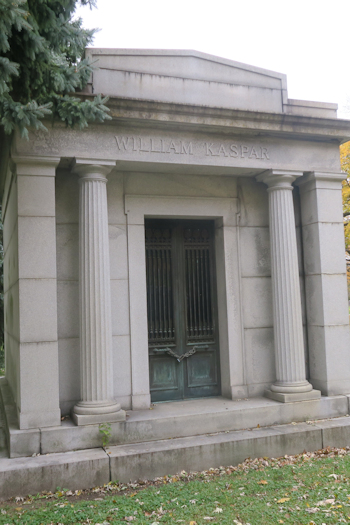
William Kaspar
September 1, 1835 Bohemia
November 2, 1922 Chicago
Lot 1 Section 14
Sergeant Company I 4th Massachusetts Infantry, mustered in September 18, 1862
Wounded June 14, 1863, Mustered Out August 28, 1863, Lakeville, Massachusetts
Pension 4th Massachusetts Infantry
DH Obit: William,Kaspar,3,Nov,1922
Find A Grave # 95111626
Military Headstone: No
Left Photo - Click Here For Larger Image
Right Photo - Click Here For Larger Image

Chicago Tribune on November 3, 1922: “William Kaspar, 88 years old, founder of the Kaspar State bank at 19th Street and Blue Island Avenue, died last night at his home, 3234 West Washington Boulevard. He is survived by his widow and four grown children. Mr. Kaspar had not been actively identified with the management of the bank for several years. Otto Kaspar, Vice President and Director, being in charge.”
Published in 1931, the book Massachusetts Soldiers, Sailors and Marines in the Civil War by the Adjutant General of the State of Massachusetts has a listing for William Kaspar. The book (page 260) lists William Kaspar as a Sargeant, residing in Kingston at age 26, with occupation of baker. William Kaspar is listed as enrolling on September 22, 1862 as a private, promoted to Sargeant and mustered in on September 23, 1862. He was wounded at Port Hudson, Louisiana on June 14, 1863, and mustered out on August 28, 1863. (Click Here To View William Kaspar Summary Page 260)
Page 228 of the book contains a summary of the Nine Month volunteers. “Under the call of August 4, 1862, for 300,000 militia to serve nine months, 19.080 being the number assigned to the quota of Massachusetts, the 4th. Regt. Again volunteered and was ordered to Camp Joe Hooker at Lakeville, Mass., to recruit to war strength. Its companies were mustered into the United States service on various dates between Sept. 1, and Sept. 26, while the field and staff were mostly mustered December 16. On the 27th of December the regiment proceeded to New York where it embarked for Louisiana. It left New York Harbor January 3, 1863, and arrived at Carrolton, La., February 13. On March 7 it arrived at Baton Rouge, La., forming a part of Ingraham’s Brigade, Emory’s Division, 19th Corps. Here it cooperated with the Nvy in the attempt of Admiral Farragut to run past the Port Hudson batteries. It engaged in the attack on Fort Bisland, April 11 to 13, and joined in the pursuit of the Confederates as far as Franklin. From the last of April until the 30th of May it was in or near Brashear City. During the first two weeks in June it participated in the siege of Port Hudson and on June 14 took part in the assault. After the surrender of the city July 8, the 4th Regt. Did garrison duty in the defenses until the termination of its period of enlistment. The regiment started for home via Cairo, Ill., on the 4th of August and arrived in Boston on the 17th. It was mustered out at Camp Hoe Hooker, August 28.”
William Kaspar, in his February 20, 1861 Naturalization record from the Superior Court of Plymouth County, Plymouth, Massachusetts lists his birth date as August 3, 1837, and his arrival in the United States at New York on November 3, 1853.[i] (The History of Cook County lists his birth date as September 1, 1835. (View Naturalization Index Record View Massachusetts Naturalization Petition)
By 1864, William was in Chicago was engaged in the grocery and baking business. Bubinicek describes Kaspar’s bakery as being located on Dekovan Street.[ii] He sold his business in 1871 and returned to Bohemia, only to return after a short stay on June, 29, 1872 (ports Bremen and Southampton to port New York City, aboard the ship Main).
After his return, William’s activities centered on real estate and insurance. In 1888, there was a Kaspar and Karel private bank. In 1902 William Kaspar organized the Kaspar State Bank.
View Image #2 Kaspar State Bank
View Image Lithograph William Kaspar From Google Images
View Newspaper Article - William Kaspar Celebrates 87th Birthday
William Kaspar was married twice. He first married Julia Wondrejka on January 9, 1867 at Saint Wenceslaus Catholic Church in Chicago. (Click Here To View 1st Marriage Record) Julia died in 1887. He later married Paula Mandl in 1889. The book, “History of Cook County, Volume 1, described several of his activities: “He is a member of the U.S. Grant Post G.A.R.F & A. M, the Royal Arch Masons and Shriners, and also of the Odd Fellows. He served two terms with the board of directors of the public library and in politics is a Republican.”[iii]
Obituary for William Kaspar from the Denni Hlasatel on November 3, 1922:
Mr. William Kasper, founder and president of the Kaspar State Bank, passed away yesterday, and we perceive with sadness the thinning ranks of our pioneers. After difficult but successful careers they leave, one by one: but they leave to their progeny and their countrymen shining examples of perseverance, industry, enterprise, and all the other beautiful virtues which adorned their character.
Perhaps the oldest Bohemian pioneer, both as regards age and length of sojourn in this land, was Mr. William Kaspar. He was one of the most successful of our countrymen, for he founded a strong banking institution which had the full confidence of the entire [Czech] colony, commanding the respect of the highest financial circles in the United States. Everyone who knew Mr. Kaspar and who 2had the opportunity of meeting him frequently, wondered at his physical buoyancy and his mental alertness, both of which traits Mr. Kaspar retained till they very end of his life. His personality and that of his bank seemed to have fused into one. Being a farseeing man and bearing in mind, therefore, the possibility of a disorganizing shock which the institution would suffer by his sudden demise, he entrusted the direction of all business to his son, Mr. Otto Kaspar, five years ago. Thus Mr. Otto Kaspar not only became a vice-president of this bank, but also the president of the board of directors. During that five-year interim Mr. Otto Kaspar learned to hold the reins of the government of his bank and will now continue to be its head.
Although Mr. William Kaspar unloaded the heaviest burden of management upon the shoulders of his son, he continued to work in the bank; his pleasant smile greeted every customer. Everyone will miss that smile; everyone will bear painfully the loss of the old gentlemen; everyone will miss his smiling face and his sincers handclasp as well as his friendly discourses. His leaving produced a niche in the old institution, a niche which will be difficult to 3fill. But as regards all the business matters, these shall continue to be handled by Mr. Otto Kasper, handled in the same able and strictly honest manner as was the wont of the old gentleman.
The death of Mr. William Kasper occurred last night at 8:45 P. M. at his residence, 3234 West Washington Boulevard. It was reallty an imperceptible transition from a temporal sleep to an eternal one. His ailment lasted only four days, and his demise will therefore shock our entire public: for outside of the immediate family no one imagined that his condition was so serious. It was only recently that most of us either saw him or spoke with him, and none of us saw any signs of an approaching physical breakdown.
The biography of Mr. William Kaspar contains many interesting and enlightening features and should be recorded in detail to leave an example for all future generations. Mr. William Kaspar was born in the town of Holice, Bohemia, on September 1, 1835; he died at the age of eighty-seven years and two months. He came to the United States as an eighteen-year-old lad in 1853. A remarkable.
4coincidence is the fact that his foot touched the soil of his new homeland on November 2, that is, on the day of the month that, sixty-nine years later, he journeyed to eternity.
Young William Kaspar settled in the East, in Massachusetts. Chicago at that time had not yet become attractive to the immigrants. He worked in Boston and in other cities. In September. 1862, he joined the Union Army as a man of twenty-seven years to fight for the preservation of the Union. He was assigned to the Fourth Massachusetts Infantry Regiment and with it was sent to Louisiana, in the vicinity of New Orleans. His military service ended in August. 1863, when he was honorably discharged as a sergeant and an invalid. During an assault on Fort Hudson, June 14, 1863, he was badly wounded and later declared unfit for further military service.
He came to Chicago in 1864. Here he found a flourishing Bohemian settlement which he joined and in which he tried to utilize his knowledge of language and conditions, both of which he gained during his eleven-year stay in the East 5and in military service. He started out as a grocer, and there are several countrymen who still remembers his grocery store on Canal Street and De Koven Street. Even in those days he became the confidant of many countrymen who, looking upon him as a man of experience and trust, asked him to guard their earnings. This induced him to open a private bank in August, 1888. He took as his partner Mr. John L. Karel, and the bank was managed under the firm name of Kaspar and Karel.
In 1905 Mr. Kaspar caused his bank to be incorporated as a state institution, thus insuring its brilliant future. Out of its humble beginnings it developed into an institution of many millions [of dollars], and Mr. Kaspar took care that it continue to grow even after his death.
Mr. Kaspar was a good Bohemian; it was always easy to see what pleasure he derived from a Czech conversation. He contributed willingly to our national and charitable institutions. He leaves a wife, Pavla (nee Mandel), two sons, Otto and Eugene, and two married daughters. One of his granddaughters, 6Miss Weisel, is to celebrate her wedding with the some of Mr. Janovsky of Town of Lake; the grandfather was anticipating this event with such great pleasure; alas, he did not live to be present at that wedding which, because of his death, must now be postooned. Two of his brothers and a sister also morn the departed one.
Funeral services for Mr. William Kaspar will be held tomorrow, Saturday, at 2 P. M., at the Masonic Hall on Millard Avenue. The obsequies will be at the Cesky Narodni Hrbitov. (Bohemian National Cemetery). The undertaking establishment of Carmak and Kostecka will be in charge of the funeral."
[i] National Archives at Boston; Waltham, Massachusetts; ARC Title: Copies of Petitions and Records of Naturalization in New England Courts, 1939 - ca. 1942; NAI Number: 4752894; Record Group Title: Records of the Immigration and Naturalization Service, 1787-2004; Record Group Number: RG 85. Ancestry.com. Massachusetts, State and Federal Naturalization Records, 1798-1950 [database on-line]. Provo, UT, USA: Ancestry.com Operations, Inc., 2011.
[ii] A history of the Czechs in Chicago, Collected and Organized by Rudolf Bubenicek. Translated by Karleen Chott Sheppard CSAGSI, Chicago, Illinois, 1939. Privately printed. Typesetting by West Side Press. Printed and bound by R. Mejdrich and Company. Page 168.
[iii] A History of Cook County, Volume 1, Weston Arthur Goodspeed and Daniel David Healy, Goodspeed Publishing Company, 1909, Chicago. Pages 758.
Jacob Kristufek
August 15, 1826 Talin #18, Mysenec, Pisek Bohemia
December 19, 1895 Chicago
Lot 13 Block 4 Section T
Private Company C 5th Missouri Volunteer Infantry Regiment
Enrolled May 4, 1861 Saint Louis Arsenal
Mustered In June 3, 1861 Saint Louis Mustered Out August 24, 1861 Saint Louis
Pension: Listed under Jacob Kristfeck Company C 5th Missouri Infantry
DH Obit: Jakub, Kristufek, 20, Dec., 1895
Find A Grave: # 95111150
Military Headstone:??
No Military Headstone Found
Click here for larger view of right image
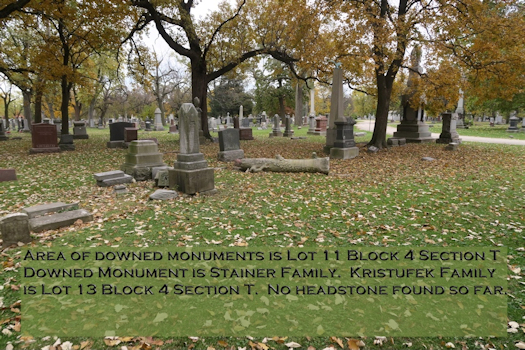
The 5th Missouri Volunteer Infantry Regiment was in existence for only three months. (View Jacob's Three Month Enlistment Record) They participated in several engagements within Missouri and were disbanded. [i]
Family Search has a short summary: “This regiment was organized at St. Louis, Mo., May 18, 1861. It was attached to Lyons' Army of the West. Expedition from St. Louis to Potosi May 15 (Co. "A"). Moved to Springfield, Mo., June 16-17. Action at Dry Forks July 5. Expedition toward Fayette, Ark., August 3-5. Battle of Wilson's Creek August 10. March to Rolla, thence to St. Louis August 11-21. It mustered out August 27, 1861. The Colonel in charge was Charles Solomons.” (https://www.familysearch.org/wiki/en/5th_Regiment,_Missouri_Infantry_(3_months,_1861)_(Union).
There is only one Jacob Kristufek buried in Bohemian National Cemetery. Most records confirm this to be the Jacob listed on the plaque of eighteen Civil War veterans. Pension records also confirm this Jacob. There is a question though. Jacob and his family are listed in the 1860 Chicago census. Yet Jacob Kristufek, the one with the pension records for his Missouri unit and his burial in BNC, enrolled in the 5th Missouri Volunteer Regiment at the Saint Louis Arsenal on May 4, 1861 and was mustered into the unit on June 6, 1861 in Saint Louis.[ii] Is there some unknown reason why Jacob would leave Chicago, perhaps take the train to Saint Louis, and join the 5th Missouri in 1861?
The 1922 Roll of Honor, published by the Cook County Commissioners, while the Roll of Honor does not list Jacob Kristufek, it does list a Joseph Kristafek in the 3rd Illinois Infantry, buried in Bohemian National Cemetery. This Joseph Kristafek died on November 22, 1897. Joseph is listed as buried at Lot 75 Section 14. That name with that date, nor the name with the lot and section number, does not exist in the BNC Death Index.
Jacob Kristufek was born on August 15, 1826 at Talin #18 in the Pisek region of Bohemia. (View Jacob's Birth Record) Jacob married Anna Slepicka on August 3, 1847. (View Jacob's and Anna's Marriage Record) Son Mathias were born in Bohemia before the family migrated to the United States. Son, John was born in 1858 in Chicago. (Thank you to Sharon Sherman and her very complete Ancestry Family Tree posting with her help in gathering this information.) Perhaps the reason why Jacob became a member of the Missouri military, comes from Sharon, as she indicates that the Kristufek family first settled in Missouri.
Jacob’s 5th Missouri service record indicates his three months of enlistment in the volunteer infantry regiment, used to counter balance Confederate forces also found within the campaign region. (View Jacob's Pension Record - Widow's)
Census records use the family name Christopher instead of Kristufek.
[i] https://en.wikipedia.org/wiki/5th_Missouri_Volunteer_Infantry_(3_months,_1861)
[ii] https://www.fold3.com/image/231240885
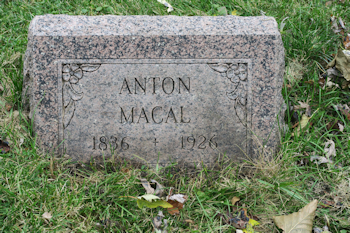
Anton Macal
April 1, 1837 Nymburk #86, Bohemia
April 18, 1926 Chicago
Lot 59 Section 12
Private Company E 12th New Jersey Regiment “Buck and Ball Regiment”
Mustered In: April 4, 1865. Mustered Out: July 14, 1865
Pension Company: E 12th New Jersey
DH Obit: Anton, Macal, 20, April 1926
Find A Grave: # 95111566
Military Headstone: No
Left Photo - Click Here For Larger Image
Right Photo - Click Here For Larger Image
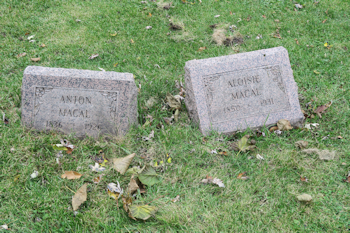
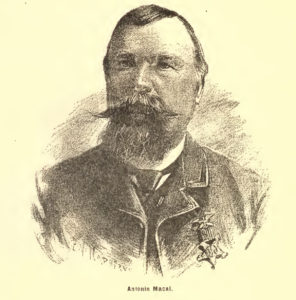 Chicago Tribune – April 20, 1926 – “Anthony Macal, beloved husband of Aloizie Macal, father of Adolph Macal, son and Wilhelmina Cross, daughter. Member of Lyon Post No 9 G.A.R. Funeral Wednesday, April 21, 1926 at 2 o’clock p.m. from chapel 2010 West 51st St. to Bohemian National Cemetery, Crawford and Foster Ave.”[i]
Chicago Tribune – April 20, 1926 – “Anthony Macal, beloved husband of Aloizie Macal, father of Adolph Macal, son and Wilhelmina Cross, daughter. Member of Lyon Post No 9 G.A.R. Funeral Wednesday, April 21, 1926 at 2 o’clock p.m. from chapel 2010 West 51st St. to Bohemian National Cemetery, Crawford and Foster Ave.”[i]
Anton Macal was born on April 1, 1837 at Nymburk #86. (Click here to view his birth record. Click here to view a close up of his name and parents names on the birth record) Family Search lists Anton’s parents as Anton Macal (Find A Grave # 138438306) and Anna Hanus. (Various spellings are used for Anton Macal, Micael, Macel). It is assumed that he was in New Jersey before the Civil War, as he began active duty at Camp Stockton, Woodbury, New Jersey on April 4, 1865 with the 12th New Jersey Infantry Regiment. (Click Here To View Pension Record) Previous to his enlistment, that unit had several significant campaign battles including Gettysburg with a monument erected there to the regiment’s exploits on the battlefield.[ii] (There is a website which honors the 12th New Jersey Regiment for their heroics at Gettysburg - http://gettysburg.stonesentinels.com/union-monuments/new-jersey/12th-new-jersey/) Yet, at the same time, an Anton Macal is listed as arriving in Chicago in1860, from an Ancestry immigration list reference (could be a reference to his father, Anton).
Roster of the Twelfth Regiment, New Jersey Volunteers : [oration by Col. William E. Potter, at the first reunion of the Regiment, Woodbury, N. J., Feb. 22, 1875. Anton Macal listed on page 34.
Anton Macal’s first marriage was to Antonie Kaspar (Find A Grave # 156539738) The location has not been found, but their son, Adolph was born in Chicago on November 11, 1868, baptized at Saint Wenceslaus Catholic Church.[iii] Daughter Minnie, was born shortly before the 1870 census, which lists Anton and family as Martsel.
Chicago directory and census records lists Anton as a machine agent and sewing machine agent for a number of years. Later census records (1900, 1910) listed Anton as a cigar maker.
Anton’s first wife Antonie Kaspar Macal died in 1895 and is buried with a young daughter Milada in Grave 6, Lot 2, Section L. Anton married Aloisa Stengle (Stengle) on July 31, 1897 in Chicago. Anton is buried in Lot 59, Section 12 with Aloise.
[i] Chicago Daily Tribune; Chicago, Ill. [Chicago, Ill ]20 Apr 1926: 37.
[ii] https://en.wikipedia.org/wiki/12th_New_Jersey_Volunteer_Infantry
[iii] "Illinois, Chicago, Catholic Church Records, 1833-1925," database with images, FamilySearch (https://familysearch.org/ark:/61903/3:1:S3HY-XHG3-BKQ?cc=1452409&wc=M66P-ZTB%3A40444701%2C40451801 : 20 May 2014), St Wenceslaus Parish (Chicago: DeKoven St) > Baptisms 1866-1871 > image 32 of 67; Catholic Church parishes, Chicago Diocese, Chicago.
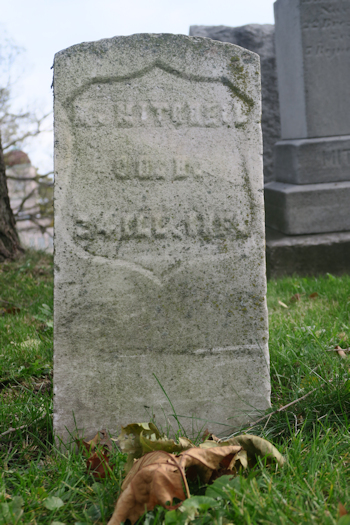
Mathew Mitchell (Mitchel)
September 7, 1835 Bohemia
April 7, 1901 Chicago
Lot 9 Block 2 Section K
Private Company B 24th Illinois Infantry (Bloomington, Illinois listed) “Old Hecker Regiment”
Mustered in July 8, 1861. Mustered Out August 6, 1864.
Pension: Company B 24th Illinois Infantry
DH Obit. Matous, Mitchell, 8, Apr., 1901
Find A Grave: # 31136594
Military Headstone: Yes
Left Photo - Click Here For Larger Image
Right Photo - Click Here For Larger Image

The Mitchell family has a very good ancestry family tree site. Through their hard work and research the owner of the family tree posted the Mitchell family arrived from port Bremen to port NYC on June 22, 1855, aboard the ship “Mimi”. The spelling used was Mickschel (one can understand how it became Mitchell). The registry listed four adults and seven children, which included Matthew (Mathias). The same family tree listed Matthew’s birth as Ostrov, Prachatice. I found Matthew in the Birth Marriage Death Index Book 55, Image 66, but could not decipher the town. I was not able to find the actual birth record and village.
Mathew Mitchell, originally listed as Bloomington, Illinois, joined Company B of the 24th Illinois Infantry on July 8, 1961. The unit began its military history after arriving in Alton, Illinois. Most campaign activities were in the states of Kentucky and Tennessee, with participation in the Battle of Chickamauga and Sherman’s campaign in Georgia, perhaps the most notable. “It was the first command of Union troops that trod the soil of Kentucky during the earlier days of the Rebellion, and upon its arrival at Louisville, the loyal people there accorded the Regiment a most hospitable and brilliant reception.” (Illinois Adjutant General’s Report Regimental and Unit Histories 1861 – 1866, page 69, published 1900) The 24th Illinois became part of the Army of Ohio until November 1862, and after that was assigned as a unit within the Army of Cumberland until Mathew was mustered out on August 6, 1864.[i]
Five of the eighteen veterans listed on the Civil War Plaque were members of the 24th Illinois Infantry. Prokop Hudek, Frank Smola, John Talafous and Alois Uher were in Company F. Matthew Mitchell was in Company B. The Illinois Adjuntant General's Report on Regiment and Unit Histories 1861 - 1865, published in 1900, has a very good summary of the 24th Infantry's actions in the Civil War. All five of these veterans are also listed in the book as members of the unit. PDF file describing the 24th Infantry's actions in the Civil War.
Those Ancestry family trees indicate that Mathew married Frantiska Kubert in 1864 in Chicago.
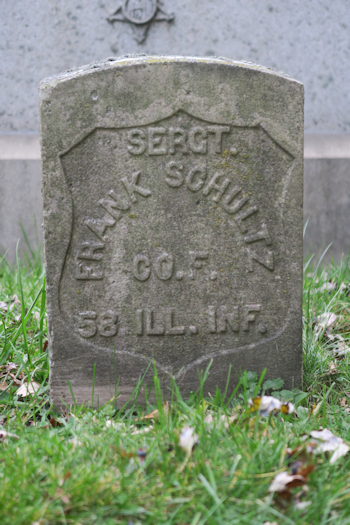
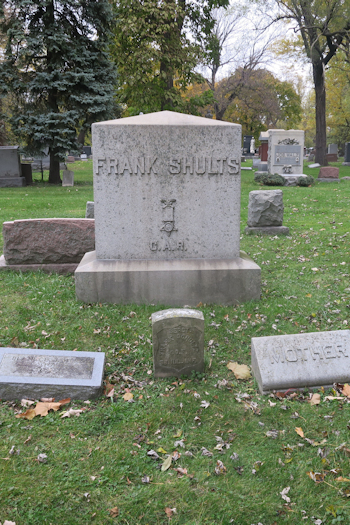
Frank Schultz (Shulz, Shults)
November 26, 1844 Turkovice # 44, Bohemia View Birth Record
January 22, 1917 Chicago
Lot 9 Section 15
Private Company C 58th Illinois Infantry – Mustered in: 1-1-1864, Mustered out 4-1-1866 as Sergeant
Pension: 58th Illinois Infantry
DH Obit: None Found
Find A Grave: # 95111506 and # 90649315 and # 47268764
Military Headstone: Yes
Note: Two headstones for Frank in this family grave site. Military lists last name Schultz. Family headstone lists last name as Shults. In Bohemia, the family name was Sulc.
Left Photo - Click Here For Larger Image
Right Photo - Click Here For Larger Imge
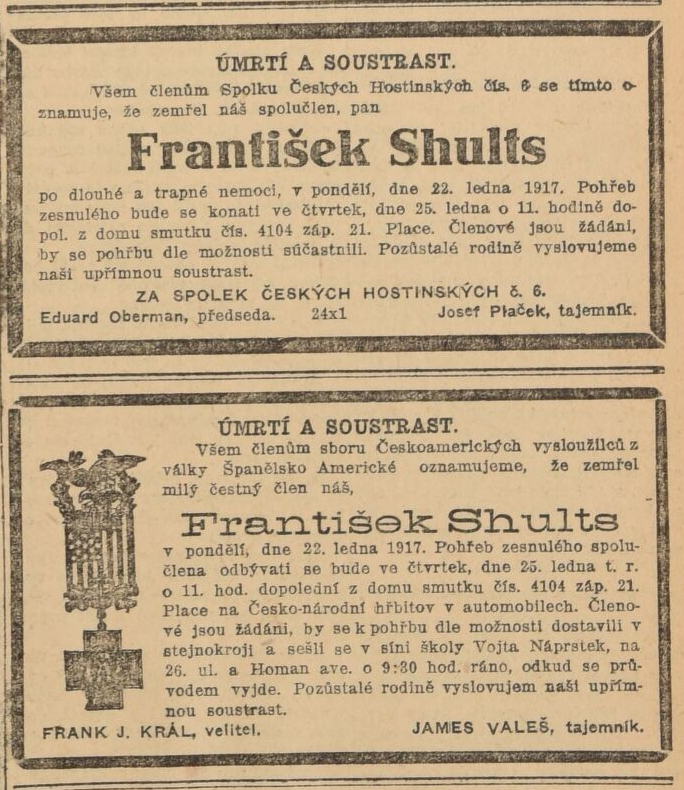
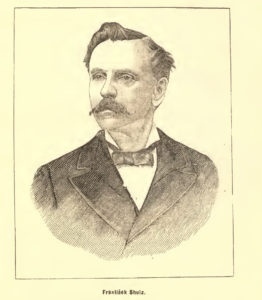 Chicago Tribune – January 23, 1917 – “Frank Shults, age 72 years, beloved husband of Katharine, father of Frank, John, Beatrice, and Agatha, brother of William J. Shults and Mrs. Anna Kouba and the late Joseph and James Shults, member of Gen. Geo. A. Custer post No. 40, G.A.R.; honorary member Spanish American War Veterans, also member Oddfellows, Knights of Pythias, Bohemian Old Settlers’ association, and Bohemian Turners. Funeral from late residence, 4104 W. 21st place, Thursday, Jan. 25, at 11 a.m. to Bohemian National cemetery.”
Chicago Tribune – January 23, 1917 – “Frank Shults, age 72 years, beloved husband of Katharine, father of Frank, John, Beatrice, and Agatha, brother of William J. Shults and Mrs. Anna Kouba and the late Joseph and James Shults, member of Gen. Geo. A. Custer post No. 40, G.A.R.; honorary member Spanish American War Veterans, also member Oddfellows, Knights of Pythias, Bohemian Old Settlers’ association, and Bohemian Turners. Funeral from late residence, 4104 W. 21st place, Thursday, Jan. 25, at 11 a.m. to Bohemian National cemetery.”
Frantisek Schultz arrived with his family (father, Jacob 36, mother Maria 36, Franz 10, Maria 7, Wenzel (Vaclav), Joseph 3 and Anton 6/12 on December 19, 1854 from port Bremen to port New York City, aboard the Grosserzogerver Oldenburg.
A book, Report of the Adjutant General of the State of Illinois – Volume 4 – 1861 – 1866 Published 1900 lists on page 118: Frank Schutz of Chicago, Company C, 58th Illinois Infantry, enrolling on 1-1-1864, mustering on 1-2-1864 and mustering out on 4-1-1866. Click Here to View Roster and History of 58th Illinois Infantry.
Pages 107 and 108 describe: “The Fifty-eighth Illinois Infantry Volunteers was recruited at Camp Douglas, Chicago, Illinois on the 11th of February, 1862. The Regiment left Camp Douglas, 887 strong via the Illinois Central Railroad, for Cairo. Illinois, and reported to Brigadier General E. A. Paine, on the 12th. Was immediately furnished with arms and started from Cairo about midnight, with orders to proceed up the Ohio to Smithland, Ky.. thence up the Cumberland, to the vicinity of Fort Donelson, and report to the officer in charge of United States' forces…..Arrived near Fort Donelson on the night of the 13th, and disembarked at daybreak, the 14th,having been assigned to the Third Brigade, Third Division.  Colonel J. M. Thayer, First Nebraska, commanding…. On the 29th of March embarked on steamer, and went up to Pittsburg Landing….On the morning of Sunday, the 6th of April….About 2,300 officers and men were captured in this fight by the enemy. The surrender did not all take place the same time. The surrender of the Fifty-eighth was made a few minutes before six. The loss in this engagement was frightful—amounting in killed, wounded and prisoners, to upwards of 450. More than three-fourths of those taken prisoners were wounded, and only 218 were taken prisoners. The fact of the Regiment being taken, was. undoubtedly, in a great measure, the salvation of the army. The right and left were entirely turned, and the enemy, on one wing only, needed to know of the success of the other, to press on; but while the center held out they could not-know their success. And when, at last, this small band was forced to succumb, night closed her mantle over the scene, and the haughty victors could pursue their advantage no further. Suffering all the privations and hardships which the rebels knew so well how to inflict on their helpless victims, for about seven months, the prisoners or what was left of them, about 130 men, were paroled and allowed to go north…… Mustered out at Montgomery, Ala.. April 1, vm, and ordered to Springfield, Illinois, for final payment and discharge.” View Pension Record
Colonel J. M. Thayer, First Nebraska, commanding…. On the 29th of March embarked on steamer, and went up to Pittsburg Landing….On the morning of Sunday, the 6th of April….About 2,300 officers and men were captured in this fight by the enemy. The surrender did not all take place the same time. The surrender of the Fifty-eighth was made a few minutes before six. The loss in this engagement was frightful—amounting in killed, wounded and prisoners, to upwards of 450. More than three-fourths of those taken prisoners were wounded, and only 218 were taken prisoners. The fact of the Regiment being taken, was. undoubtedly, in a great measure, the salvation of the army. The right and left were entirely turned, and the enemy, on one wing only, needed to know of the success of the other, to press on; but while the center held out they could not-know their success. And when, at last, this small band was forced to succumb, night closed her mantle over the scene, and the haughty victors could pursue their advantage no further. Suffering all the privations and hardships which the rebels knew so well how to inflict on their helpless victims, for about seven months, the prisoners or what was left of them, about 130 men, were paroled and allowed to go north…… Mustered out at Montgomery, Ala.. April 1, vm, and ordered to Springfield, Illinois, for final payment and discharge.” View Pension Record
Bubenicek describes that Frank was wounded twice at the battles of Fort Donelson and Fort Henry and was a prisoner at Andersonville for three months.[i] Frank married Mary Hruby on February 12, 1867 at Saint Wenceslaus Catholic Church. (View Marriage Record) Mary died in 1881. Frank married Catherine Tercel in 1882. Most of the census and Chicago directory records indicate that Frank was a saloon keeper for most of his working life.
[i] A history of the Czechs in Chicago, Collected and Organized by Rudolf Bubenicek. Translated by Karleen Chott Sheppard CSAGSI, Chicago, Illinois, 1939. Privately printed. Typesetting by West Side Press. Printed and bound by R. Mejdrich and Company. Page 66.
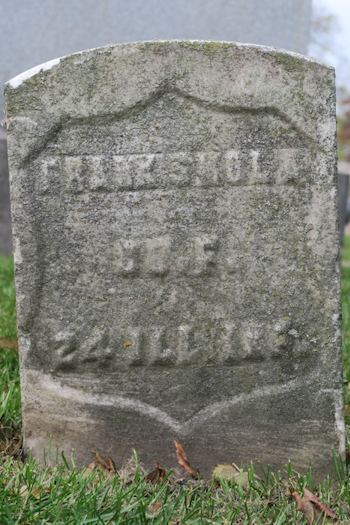
Frank Smola
Lot 19 Block 1 Section W
June 28, 1843 Roven #39 Vamberk Rychnov Nad Kneznou
May 6, 1903 Chicago
Private Company F 24th Illinois Infantry “Old Hecker Regiment”
Mustered in July 8, 1861. Mustered Out August 6, 1864.
Pension Company F 24th Illinois Infantry
DH Obit: Frantisek, Smola, 7, May, 1903
Find A Grave # 95111460
Military Headstone: Yes
Left Photo - Click Here For Larger Image
Right Photo - Click Here For Larger Image
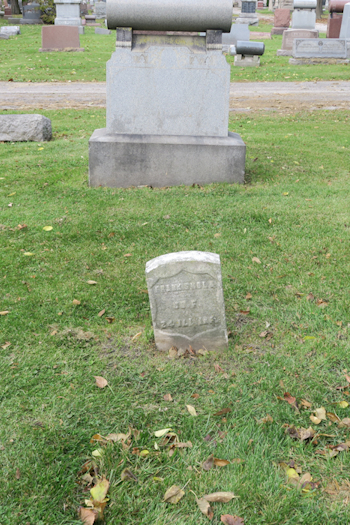
Rudolf Bubenicek, in his book, describes that Alois Uher, Frank Smola, Prokop Hudek and Jan Talafous (all named on the monument plaque), signed up to join the Slavonic Company on 1, 1861 while gathered at Anton Mach’s tavern, which was located at the corner of Canal and Randolph Streets.[i] While actually enlisted in Chicago, the unit began its military history after arriving in Alton, Illinois. Most campaign activities were in the states of Kentucky and Tennessee, with participation in the Battle of Chickamauga and Sherman’s campaign in Georgia, perhaps the most notable. Alois was mustered out in Chicago with the rank of First Sergeant.
Five of the eighteen veterans listed on the Civil War Plaque were members of the 24th Illinois Infantry. Prokop Hudek, Frank Smola, John Talafous and Alois Uher were in Company F. Matthew Mitchell was in Company B. The Illinois Adjuntant General's Report on Regiment and Unit Histories 1861 - 1865, published in 1900, has a very good summary of the 24th Infantry's actions in the Civil War. All five of these veterans are also listed in the book as members of the unit. PDF file describing the 24th Infantry's actions in the Civil War. View Roster of 24th Illinois Infantry From Illinois Adjutant General's Regiment and Unit Histories 1861 - 1866
Frank Smola was born in 1843 and the Ancestry family trees, and census records list Frank arriving around 1860. View Frank's birth record. There is a request record for Frank Smola's Veterans Headstone. There is a record for Frank Smola's Civil War Veteran's pension.
Frank Smola married Marie Novotny on July 17, 1866 at Holy Family Church (West 12th Street) in Chicago. Census and Chicago Directory listings list Frank’s occupation as a harness and saddle maker. One Ancestry Family Tree has posted a picture of Frank Smola’s Chicago harness shop.
In 1870, the census (Illinois, Cook, Chicago, Ward 9, Page 80) has the family listed as Smaller. Frank 24, Mary 24, Jane 3, John 2, Frank 3/12. Frank is listed as a harness maker. In 1880 their address is 174 DeKoven. In 1900 their address is 362 West 20th Street.
The Frank Smola gravesite Lot 19, Block 1, Section W, seems to have only Frank’s headstone, yet the Smola family is listed in the BNC Index as being also buried in the gravesite. Those listed are Infant Smola 1901, age 0, Eman 1897, age 12, Frank 1903, age 59 George 1950, age 58, Jennie 1907 age 41, Martha 1907, age 1, and Frank’s wife, Mary, 1915, age 69.
[i] Bubenicek, Rudolf: A history of Czechs in Chicago. Translated by the Czech and Slovak Genealogy Society of Illinois. 2011. Pages 61-62.
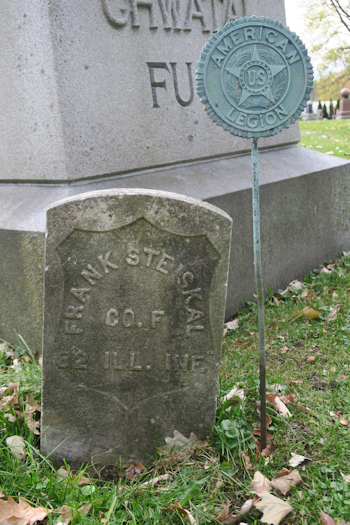
Frank Stejskal (Steiskal used for most records and BNC headstone)
Lot 5 Block 1 Section V
December 20, 1841 Horice Horni #10, Hartvikov, Tabor, Bohemia
March 17, 1932 Chicago
Private Company F 82nd Illinois Infantry “2nd Hecker Regiment”
Pension: Companies A and F 82nd Illinois Infantry
DH Obit. Frank, Steiskal, 18, March, 1932
Find A Grave: Two Postings # 139114068
Military Headstone: Yes
Photo Left - Click Here For Larger Image
Photo Right - Chick Here For Larger Image
Parents Also Buried in BNC
Frank #132634516
Antoine #132634498
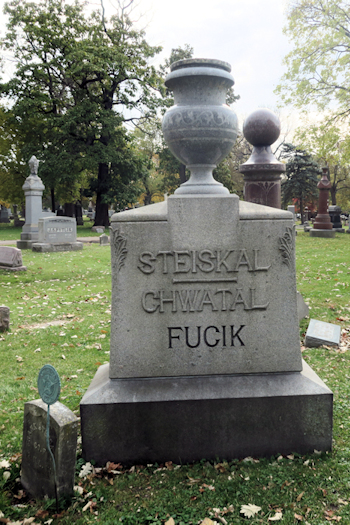
Chicago Tribune – March 18, 1932 – “Frank Steiskal, last surviving veteran of the 82nd Illinois Volunteers infantry regiment, died yesterday at the age of 90. He marched with Sherman to the sea, was wounded three times and nearly lost his eyesight in the civil war. Mr. Steiskal was a retired banker, and lived at 4944 West Monroe Street. Funeral Services will be held at 1 p.m. tomorrow at the chapel at 5708 West Madison Street. Burial will be in the Bohemian National cemetery. Mr. Steiskal was born in Bohemia and came to the United States as an immigrant in 1854. He enlisted in 1862 and served until 1865, when he came to Chicago. He is survived by a son and a daughter. He was commander of Columbia post, No 706, G.A.R., and an honorary member of the Spanish War Veterans.”
Frank Stejskal (spelling at birth) was born on December 20, 1841 at Horice Horni #10 to Frank and Antoine Stejskal. (Click Here To View Birth Record) Three other siblings would also be born there before the family departed to the United States on September 1, 1854 aboard the ship Transit bound for Hull. The ship used in their arrival to the United States has not yet been verified.
Frank Stejskal (Steiskal), parents and siblings, first lived in Manitowoc County, Wisconsin after his arrival in the United States before being mentioned in the “History of Cook County” as being a merchant in 1860. A brother John, and sister Mary, were born in Manitowoc County, Wisconsin.
Frank was mustered into the 82nd Illinois Infantry on October 23, 1862. His unit fought at Chancellorsville in May of 1863. He was wounded and taken prisoner, spending time at Libby and Belle Island prisons. Frank was released, recuperated, and rejoined his unit for major engagements at Look Out Mountain, Missionary Ridge, and the battle for Atlanta. Frank’s unit continued on with Sherman as his army marched to the Sea and later in North Carolina. Frank was discharged on July 1, 1865.[i]
PDF File Summarizing the history of the 82nd Infantry during the Civil War.
Web Link to the 82nd Infantry Monument at Gettysburg.
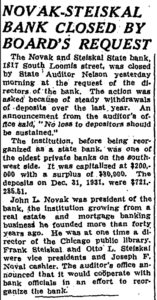
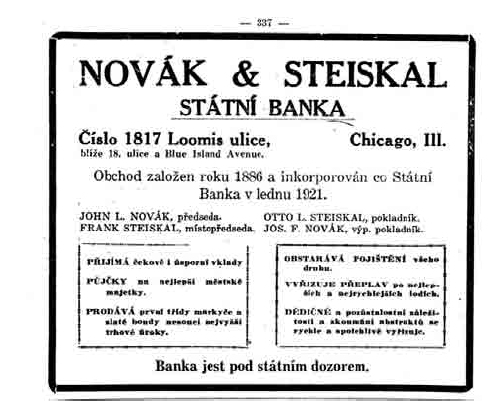 Frank married Marie Chladek in Chicago in 1870. During that time he was a merchant in the hardware business, but that ended in 1871 when his property was destroyed in the Chicago Fire. The furniture business would become his next venture. Frank, Marie and children, lived in Kewaunee, Wisconsin as 1882, 1885 and 1890 census data reveals, while at the same time during the 1880’s his parents and siblings were living in Chicago. Kewaunee records also list another Civil War veteran, Edward Carl, private, 24th Illinois Infantry regiment, also living in Kewaunee.
Frank married Marie Chladek in Chicago in 1870. During that time he was a merchant in the hardware business, but that ended in 1871 when his property was destroyed in the Chicago Fire. The furniture business would become his next venture. Frank, Marie and children, lived in Kewaunee, Wisconsin as 1882, 1885 and 1890 census data reveals, while at the same time during the 1880’s his parents and siblings were living in Chicago. Kewaunee records also list another Civil War veteran, Edward Carl, private, 24th Illinois Infantry regiment, also living in Kewaunee.
In 1892, with a partner, John Novak, Frank first engaged in the real estate and mortgage banking.[ii] Frank also served a term as president of the John Huss Council, and was secretary and treasurer of the Bohemian Old Settlers’ Association. Most of Frank’s family, parents and siblings are buried in Bohemian National Cemetery.
PDF Frank Steiskal participation in Lincoln Memorial Event
PDF File Frank Steiskal participation in Oakwood Cemetery Memorial Event
Click Here For Image - Frank Steiskal Veteran Headstone Request
[i] A History of Cook County, Volume 2, Weston Arthur Goodspeed and Daniel David Healy, Goodspeed Publishing Company, 1909, Chicago. Pages 697 – 698.
[ii] History of Cook County, Volume 2, Weston Arthur Goodspeed and Daniel David Healy, Goodspeed Publishing Company, 1909, Chicago, Page 697 – 698.
Article - Spring 1997 - CSAGSI Journal Koreny
Dejiny Obcanske Valky S Pripojenim Zkusenosti Ceskych Vojinu
History of the Civil War - A Collection of Experiences of Czech Soldiers - Joseph Cermak - 1889
Translation by Robert O. Uher.
Frantisek Stejskal
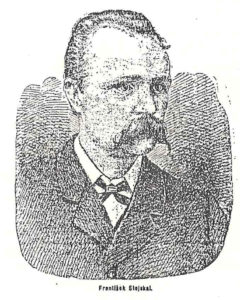 Frantisek Stejskal was born December 17, 1841 in Horice, Tabor district of Bohemia. He came to America with his parents in 1854 and on August 2, 1862 enlisted in the 82nd Regiment of the Illinois Volunteers at Chicago.
Frantisek Stejskal was born December 17, 1841 in Horice, Tabor district of Bohemia. He came to America with his parents in 1854 and on August 2, 1862 enlisted in the 82nd Regiment of the Illinois Volunteers at Chicago.
Of his first experiences he writes the following: From the start of soldiering was agreeable enough, the food was abundant however I also experienced a bitter disappointment. In the organizing of our regiment I was promised that I would be made a sergeant however my "good friend" a Czech Israelite did not behave well toward us Czechs and instead of a sergeant I was offered a corporal's rank which I did not accept.
On November 3rd., we left Chicago for the field and many friends came to bid us farewell. From here the train took us thru Pittsburgh and Baltimore to Washington, from there we went to Virginia where we were assigned to the 11th Army Corps headed by Gen. Siegel.
This group formed a part of the Army of the Potomac headed by Gen. Burnside. From here we went to Acquia Creek where we arrived after the unfortunate battle of Fredericksburg where so many of our people fell in battle.
Here we suffered severe hunger. As a result of Burnside's failure there appeared shortages everywhere and we were not given any provisions. The following events are a good illustration of the unfortunate condition in which we found ourselves. When we did not know what to do about the feeling of hunger I went out with a comrade to hunt. We saw where a number of beef cattle had been killed in a ravine. Here my comrade found a partly buried, gnawed shin bone which we quickly dug up and washed in a nearby stream, cut up and began to boil it for soup.
We had no salt but even this we managed by using gun powder as a substitute and with an appetite we partook of the soup which resembled ink. After this "feast" we returned to our regiment. The tormenting condition continued for a number of days until finally we received some provisions. Soon after this we withdrew to Stafford Court troupe where we build small wooded houses for the winter.
We prepared our beds with leaves for mattresses and this way spent the winter. Our quarters were comfortable enough and the winter not so severe as that of 1863. Also the three day periods of guard duty were agreeable. About the three day guard duty, I wish to mention further that every three days we were sent out of the main camp toward the enemy front as pickets. There we spent three days and nights (72 hours). A third of this time, 24 hours, we stood in the snow on guard. We were not even allowed to make a camp fire. We were divided into three smaller wtches of which the first went to the line closest to the front and stood there a full eight hours in the snow then this one went to the rear and the next advanced to the front and this way we alternated. These were difficult experiences and after the third day we returned to our camp where we were then employed on road repair. This way it continued until spring.
At the start the following Czech soldiers were in this regiment: Edward Kavka, Ant; Sadlo, Kar. Wirth, Vac. Minar, Jos. Kyspersky and Tom Kazda from Chicago.
The last named returned to his home in Manitowoc, Wis. having lost his health in the war and died soon after his return. After a number of days march and all worn out we arrived near the so-called Chancellorsville Court House where we were supposed to have a short rest period.
We received some ground coffee, hard tack, and a piece of raw meat from which we prepared our dinner. We looked forward to our long delayed nourishment when suddenly the sound of heavy gunfire rolled into our ears. Our army was being attached on the right wing. We were forced to throw aside our food and grab a rifle and already we saw gray rows of rebels approaching us. We defended ourselves desperately, but we could not resist the superior forces of Jackson and were forced to retreat; many soldiers were in flight, only our regiment and the 26th Wisconsin fought for every bit of ground. In this first sharp engagement I was wounded in the leg, and fell on the battlefield and later fell into captivity.
From the start I attempted to stop the flow of blood gushing from the wound but could not succeed at this. Thru great effort I got to a nearby stream where I washed out the wound. From the shirt I still had, I made a bandage. While I was thus seated on the ground binding up my wound I was exposed to enemy bullets which flew around thickly and when the rebels advanced forward I was again exposed to bomb shells thrown from our side. Happily however none of those messengers of death grazed me and I remained here until dusk when the battle lessened. Now there appeared in sight a disgusting sight; hordes of rebels appeared on the field and began to pick over the dead and wounded. What an inhumanity, to take from those writhing in pain whatever of value they had in their possession.
Even I became a victim of these "Southern Knights". First they turned out my pockets and took my twenty dollars and silver watch. Then they turned their attention to my pack, where I had hidden some sweets. Then they took all I had, they left and soon guards came for me. They could see that I was wounded but it did not matter to them. They said that as long as I had no broken bones I could walk because they had enough of their own wounded. One said "a Yankee must walk even tho he faints from the pain". Having a piece of wood in each hand to support myself I continued behind them with great exertion. To my joy I found in captivity another comrade from my regiment who was not wounded and he was great help to me. When we reached a house about a half mile distant we were kept there under guard until morning. Then we set out in the direction of Richmond. When we arrived at the Guinea station of the Richmond, Fredericksburg & Potomac R.R. were were camped in a field which a great rain transformed into a small lake.
Here we wallowed for three whole days and suffered the greatest hunger. A piece of spoiled pork and a little flour was all we received. What was to be done with the flour? We gathered some leaves, combined them with flour and water and baked it on potsherds in a fire, with this we drove hunger away. This was a real torment. After three days they drove us on to Richmond, the home of the Confederacy. There aftre a number of days march, worn out, weak and hungry, we were thrown into the storied Libby Prison. This prison was composed of two brick buildings, one of two floors and the other of three floors. I with others was thrown into the first floor where machinery had previously stood. What a terrible appearance this place offered. An offensive odor assailed everyone and the ground was covered with slime and vermin. Here we found many of our captured people whose weary weakened faces bore witness to the suffering which these unfortunates endured here. We were forcibly driven into this torture place and the first glance showed us what to expect. The sights which appeared here cannot even be told and are not even believable. Here the misfortune overtook me that my eyes began to pain me and I suffered vast pain from them. Since that time my optical health has never recovered.
We were in this torture chamber eight days when it was so overfilled that some of us had to be moved elsewhere. From here we were driven across the James River to Belle Island, a small island between Richmond and Manchester where there was also a large number of prisoners. We did not suffer so much here because we could at least move about in fresh air. The food was miserable and even tho we were beside the river we were not allowed to bathe or wash our tattered clothes. A guard was set up around us and whoever ventured to cross the forbidden line (death line) was shot on the spot. After a number of weeks of suffering it was announced that we were going to be released. At the end of May we were line up and between mounted gunards were driven towards Petersburg where we were camped in a forest. During the night a heavy rain occurred and the floods were transformed into a lake but we were not allowed to move from there. In the morning they drove us to City Point on the James river; at the dock stood our transport ship on which flew our beloved Star Spangled Banner. The emotions which overcame us thru this sight cannot be told. There was not a man among us who did not have tears of joy streaming down his haggard face. Not far from the dock was a rebel fort over which flew the flag of the Confederacy and at the entrance to the ship was a long bench on which sat a number of our officers and those of the rebels engaging in a lively discussion. By ship were transported to Annapolis, Md., where not long ago we were camped after a short stay here we were partially recovered and then were sent to Colombus, Ohio where we were to wait until fall for an exchange of prisoners. It seemed for me a long time to wait so I decided to visit Chicago and then return to my regiment. Because we had no money we set out on foot along the tracks however everywhere along the way lodgings were offered to us and after a number of days we reached Anderson, Ind where the Pittsburgh, Fort Wayne and Chicago railroad crossed.
We went to a hotel there and when we announced we were Union soldiers going to visit, we were kindly treated and a collection taken us for us so that we could go further by train.
Enough was collected so that each of us bought a train ticket for Chicago and each had twelve dollars left over. I stayed a few days in Chicago and then went to Kossuthtown, Wisc. to my parents. After fourteen days there I returned to Columbus, Ohio and from there we were sent to Benton Barracks near St. Louis.
There I became seriously ill and was to be placed into the reserves. At my own request I was allowed to remain here and later on November 27, 1863 reported back to my own regiment which was camped at Chattanooga, near Lookout Mountain, Tenn. It is necessary to mention that the 11th and 12th Army Corps were combined into the Army of the Cumberland which made up the 20th Army Corps.
Fr. Stejskal also participated in the memorable march thru Georgia and about the battle witnessed in Dallas, Georgia he tells the following: We fought with desperate determination being continually subjected to a rain of enemy balls and many of my comrades fell here. One who stood in back of me was shot in the head and fell on me. I laid him on the ground and he died at that moment. Beside me another fell shot thru the chest and these scenes were repeated continually. My hat and glove were shot thru. We suffered the most at Kenesaw Mountain, here we advanced thru swamps and it rained constantly upon us so that for a number of days our clothes did not dry out. The greatest losses we had were on July 20th, 1864 when only 30 men remained from the company of which I was a member. At Atlanta there was not a serious battle only heavy artillery fire with balls and bomb shells were fired into the city. When we broke into the city a terrible picture appeared to us because most of the buildings were ruined.
Fr. Stejskal was assigned in Feb. 1865 to a guard unit for Gen Williams and wrote the following about the march thru South and North Carolina.
The march was similar to that from Atlanta to Savannah except that we had to feed ourselves (live off the land); the fertile area of South Carolina furnished us sufficient food however in North Carolina we experienced much hunger. We fed on small bitter beans (so called nigger beans), besides that we had roasted corn ears; however despite our suffering we all thought kind happy thoughts because are knew that the end of our torment was near.
About the return of himself and his other comrades Fr. Stejskal writes the following: At the beginning of June 1865 we were finally sent home. The feelings which overcame us cannot be told. In Washington we were placed in freight cars because passenger cars were not available. None of us anticipated the misfortune which awaited us. Between Washington and Baltimore are two tracks and just when our train crossed over from one to the other the Baltimore express rushed in at a speed of 40 miles per hour and crashed into our train. About six homeward bound soldiers were killed on the spot and 25 seriously injured. The unfortunate ones were the remnant of the 7th regiment of the New Jersey Artillery. There prevailed the general opinion that the misfortune was the fruit of the locomotive engineer who was a native born Southerner and he was nowhere to be found. The rest of the trip went swiftly and at every station we were greeted with enthusiasm We arrived at Chicago at 9 o'clock in the evening at the Canal Street depot of the Fort Wayne R.R..
Here awaited us huge throngs of people with lodges and musical bands. After overwhelming shouts of cheer and fireworks we proceeded up Canal Street to Madison Street to Clark and North to the German Turner's hall. There we were formally welcomed and hosted with a banquet at which we were served by Chicago girls and ladies.
On June 9th, 1865 we gathered for the last time at the military office on north State Street where each was honorably discharged from service.
Translator's note:
Frantisek Stejskal was born in Horice, Bohemia, Tabor District, District 17, 1841.
He was brought to America by his parents in 1854 who came through Chicago but they settled on a farm in the wilderness of Northern Wisconsin. In 1855 he left the farm to work in Green Bay, Wis. and then gradually worked his way down to Chicago by 1860. He held various jobs in Chicago and when the war broke out he enlisted for three regiments in the 82nd Illinois Volunteers Regiment.
Postwar he was very active in the Chicago Czech community and was an original member in the Slovanska Lipa Association, a treasurer of the Czech Old Settlers group and in 1876 a Charter member of C.S.A. Lodge Rovnost. He was proud to say he attained the highest rank of any Czech-American in the G.A.R., that of a Colonel of Coumbia Post #.... of the Grand Army of the Republic. He also served as the Grand Marshall of the Memorial Day Parade at the Bohemian National Cemetery and was the last surviving veteran of the Czech group. He died May 17, 1933.
P.S. He operated a number of businesses over the postwar years and in 1892 in partnership with J.L. Novak founded the Novak and Stejskal State Bank in the Pilsen area of Chicago. This bank endured until comparatively recent times.
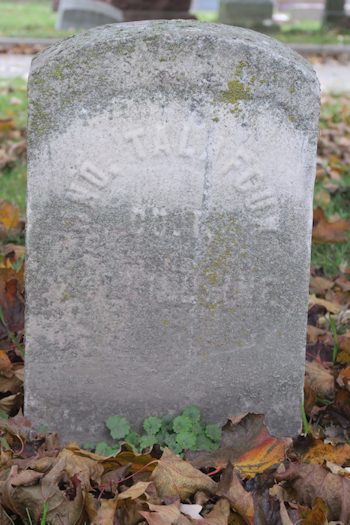
John Talafous (Talafaux)
Lot 14 Block 1 Section G
1833 Bohemia
December 5, 1889 Chicago
Private Company F 24th Illinois Infantry “Old Hecker Regiment”
Mustered in July 8, 1861. Mustered Out August 6, 1864
Pension: Company F 24th Illinois Infantry
DH Obit: No
Find A Grave # 95111331
Military Headstone: Yes
Photo Left - Click Here For Larger Image
Photo Right - Click Here For Larger Image
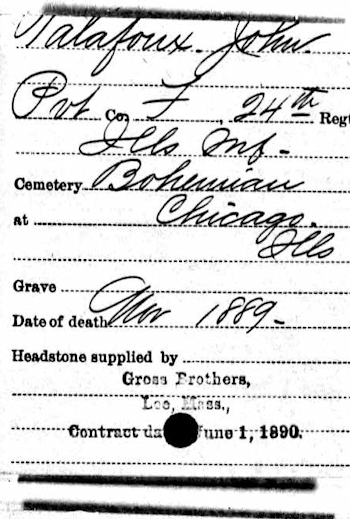
The best record found for John Talafous arriving in the United States is Johann Talasur, blacksmith, born 1833, arrived at port Baltimore from port Bremen on October 26, 1860 aboard the ship Schiller.[i]
John Talafous is listed on the National Park Service Civil War database for the 24th Illinois Infantry Regiment. John Talafous is listed on the 1929 Roll of Honor (Veterans Buried in Cook County) by the Cook County Commissioners. John Talafous has a Civil War Pension record and a Head Stone Request. But, having done a decent search, (Illinois Adjutant General’s History of Regiments and Units 1861 – 1866) John is not listed in the 24th Illinois Infantry pages for his Civil War pension record. Perhaps this is due to his "unassigned status" as shown on the pension card.
 Rudolf Bubenicek, in his book, describes that Alois Uher, Frank Smola, Prokop Hudek and Jan Talafous (all listed on the monument plaque), signed up to join the Slavonic Company on 1, 1861 while gathered at Anton Mach’s tavern, which was located at the corner of Canal and Randolph Streets.[ii] While actually enlisted in Chicago, the unit began its military history after arriving in Alton, Illinois. Most campaign activities were in the states of Kentucky and Tennessee, with participation in the Battle of Chickamauga and Sherman’s campaign in Georgia, and March to the Sea, perhaps the most notable. John was mustered out in Chicago with the rank of private.[iii]
Rudolf Bubenicek, in his book, describes that Alois Uher, Frank Smola, Prokop Hudek and Jan Talafous (all listed on the monument plaque), signed up to join the Slavonic Company on 1, 1861 while gathered at Anton Mach’s tavern, which was located at the corner of Canal and Randolph Streets.[ii] While actually enlisted in Chicago, the unit began its military history after arriving in Alton, Illinois. Most campaign activities were in the states of Kentucky and Tennessee, with participation in the Battle of Chickamauga and Sherman’s campaign in Georgia, and March to the Sea, perhaps the most notable. John was mustered out in Chicago with the rank of private.[iii]
PDF file describing the 24th Infantry's actions in the Civil War.
John Talafous married Mary Krch (Find A Grave # 146268652) around 1865 in Chicago. In the 1870 census, they were listed with three children, and in the 1880 census, they were listed with seven children. Census and city directory listings describe John as a wagon maker and a blacksmith. The 1865 city directory lists John as a blacksmith working between Ewing and Forquer Streets and living at 445 Des Plaines.
John, Mary, several children and many of Mary’s Krch (Kirch) family are buried in the same family grave site.
[i] The National Archives at Washington, D.C.; Washington, D.C.; Records of the US Customs Service, RG36; NAI Number: 2655153; Record Group Title: Records of the Immigration and Naturalization Service, 1787-2004; Record Group Number: 85
[ii] Bubenicek, Rudolf: A history of Czechs in Chicago. Translated by the Czech and Slovak Genealogy Society of Illinois. 2011. Pages 61-62.
[iii] Bubenicek, Rudolf: A history of Czechs in Chicago. Translated by the Czech and Slovak Genealogy Society of Illinois. 2011. Pages 61-62.
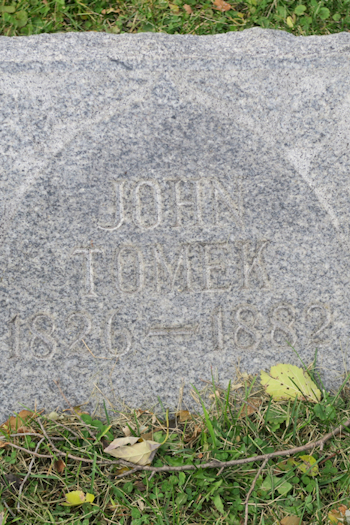
John Tomek
Lot 17 Block 2 Section K
1826 Bohemia
October 1, 1882 Chicago
Private Company F & S 19th Illinois Infantry (Tomeck spelling also used)
Unit mustered in June 17, 1861 in Chicago, Mustered out July 9, 1864, Camp Fry, Chicago
Pension:
DH Obit: No
Find A Grave # 156302983
Military Headstone: No
Photo Left - Click Here For A Larger Image
Photo Right - Click Here For A Larger Image
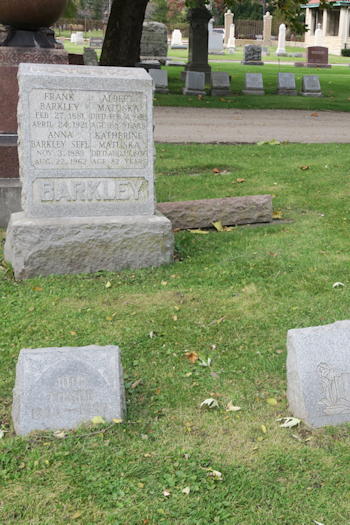
John Tomec, in Civil War records available online, was listed as a musician in Company F of the 19th Illinois Infantry Regiment. Organized in Chicago, the unit departed on July 12, 1861 and participated in battles at Stone River, Chickamauga, Missionary Ridge and Resaca. The unit returned to Chicago and the men mustered out on July 9, 1864 at Camp Fry in Chicago.[i]
The most likely record first record for John Tomek (Tomec) is the arrival on December 29, 1854 from port Bremen to port New York City aboard the ship Meta. John was listed as a tailor. The 1860 Chicago directory listed also lists John as a tailor and living at 113 Taylor. Census records have not yet been found for 1860 and 1870, but Chicago directories over that time period list John as living at 113 Taylor and being a tailor or a musician. The 1865 Illinois census and the 1871 Chicago directory list John as an individual with no other family members.
The Bubinecek book, page 43, mentions “Then amongst us came an excellent Czech musician, Mr. Jan Tomek, a composer who took hold of music very actively and accomplished a lot. He met up with Mr. Jirasek, an exceptional violinist who had been my wife’s teacher in Tyn nad Vltavou, and then with Messrs. Plocek, svoboda, Vilim, Hanzl and Kubicek. We played together for quite a while.”
In the 1880 census, two sisters are listed, Mary age 27, and Katie age 26, are also living at 113 Taylor. John is buried in the family grave site of Kaspar and Marie Vranek.
[i] Nineteenth Illinois Infantry. Nineteenth Illinois Infantry Veteran Club. 1912. M. A. Donohue and Company Publishers. Chicago. Page 7.
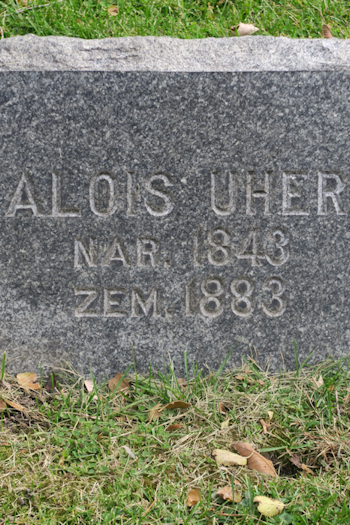
Alois Uher
May 6, 1843 Kutna Hora #11
January 2, 1883 Chicago
Lot 14 Block 2 Section K
Private Company F 24th Illinois Infantry “Old Hecker Regiment”
Mustered in July 8, 1861. Mustered Out August 6, 1864 as rank First Sgt.
Pension: No verified records found
DH Obit: No
Find A Grave: # 156304952 and # 95111231 (two postings same person)
Military Headstone: No
Photo Left - Click Here For A Larger Image
Photo Right - Click Here For A Larger Image
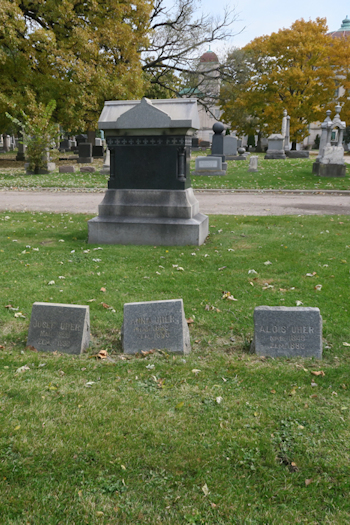
Alois Uher, born May 6, 1843 at Kutna Hora #11, (Click Here To View Birth Record) listed as age 18, arrived from port Bremen to port Baltimore on July 9, 1860 aboard the ship “Adler”. He was registered as Alonis Uher.[i] Other family members would arrive later, and he lived at the same address at varying times over the course of several decades with them: The Joseph (Find A Grave # 156304889) and Anna Uher (Find A Grave # 156304917) (parents) family that arrived on March 12, 1870 from port Bremen to port New York aboard the ship Smidt and Joseph Uher (brother) (Find A Grave # 156225612), who arrived from port Bremen to port New York on June 18, 1866 aboard the ship Mobile. Alois is buried in the same or adjacent gravesite to these individuals.
Rudolf Bubenicek, in his book, describes that Alois Uher, Frank Smola, Prokop Hudek and Jan Talafous (all named on the monument plaque), signed up to join the Slavonic Company on 1, 1861 while gathered at Anton Mach’s tavern, which was located at the corner of Canal and Randolph Streets.[ii] While actually enlisted in Chicago, the unit began its military history after arriving in Alton, Illinois. Most campaign activities were in the states of Kentucky and Tennessee, with participation in the Battle of Chickamauga and Sherman’s campaign in Georgia, and later march to the sea, perhaps the most notable. Alois was mustered out in Chicago with the rank of First Sergeant.
PDF file describing the 24th Infantry's actions in the Civil War.
In all census records and Chicago City Directories, Alois is listed as a tinsmith, as was his dad, Joseph. The 1870 census lists Aloise Uher 27, married to a Charlotte, with a child Charlotte at age 6/12. In 1880 there is the census record of Charlotte Uher, living with her parents Joseph and Frank Novak. In the 1880 census, Alois Uher is once again living with his parents, and siblings at 75 Ewing Avenue.
[i] The National Archives at Washington, D.C.; Washington, D.C.; Records of the US Customs Service, RG36; NAI Number: 2655153; Record Group Title: Records of the Immigration and Naturalization Service, 1787-2004; Record Group Number: 85
[ii] Bubenicek, Rudolf: A history of Czechs in Chicago. Translated by the Czech and Slovak Genealogy Society of Illinois. 2011. Pages 61-62.
 Article from Winter 1998 CSAGSI Journal Koreny - Translation by Robert O. Uher of an article from 1889 Amerikan Narodni Kalendar
Article from Winter 1998 CSAGSI Journal Koreny - Translation by Robert O. Uher of an article from 1889 Amerikan Narodni Kalendar
Memories of a Czech Civil War Veteran
As early organized Czech club activities in Chicago began to bloom, we often meet the name of Alois Uher, a co-founder of the Slovanska Lipa, a club whose beginnings go back to the year 1860. The members of this group endeavored to awaken the nationalistic feeling which we widely find today (1889) among the Czech community.
Among those foremost in enthusiasm was the Kutna Hora native, Alois Uher, who lingered here a comparatively short time. He participated in nationalistic activity with uncommon generosity, together with others caring for the Czech school, building the Lipa center, founding a Sokol unit, founding a singing society and especially a dramatic department. As an actor we find his name in the history of the Czech Theater in Chicago. His enthusiasm, like that of other pioneers of that time was boundless. In 1868 they were involved in the building of the present hall of the "Telocvincne Jednoty Sokol". Alois continued his untiring work to establish his own hardware store which he ran with the help of his father Josef, a new immigrant himself, until the great Chicago Fire.
Like many of the the other Czech countrymen in Chicago they lost everything. But Alois soon recovered his strength and enough enthusiasm to again set up his store He continued with nationalistic activities for a number of years until affected with a lung ailment he toppled into an early grave. As a friend of freedom and truth during the Civil War he gave his service to help the preservation of his new fatherland. While in the service he became a First Sergeant, an indication of the seriousness with which he viewed his service and for the love of his companions.
The Czech regiment was one of the first from Chicago to be called for service in the field. It happened while they lingered in Cairo, Illinois and merged with the 24th Illinois volunteer regiment. The head of this regiment was later to be Col. Geza Michaloczy, a Slovak who organized the original Czech regiment (then known as the Slavonic Lincoln Rifles). The original group was distributed among the 24th regiment with only two Czechs remaining in Company F, one of whom was Alois Uher. Alois participated in all the military engagements of his regiment.
Alois was born May 4, 1843 in Kutna Hora, Bohemia and was teh son of Josef Uher, a townsman of Kutna Hora. Josef Uher (Sr.) came to America with his family in 1870 to join his son Alois who lived here since 1860 Toward the end of 1882, Alois Uher fell ill and died January 2, 1883 of a lung ailment. He now rests at the Bohemian National Cemetery besides his dear mother and his brother Josef and near his comrades from his military period. His grave is marked by a granite headstone placed there by the caring hand of his father Josef (Sr.).
Translator's Notes: Josef Uher (Jr.), my grandfather, died April 1, 1885 and is buried beside his brother Alois who was four years older. Josef (Jr.) came to America in 1866. Alois Uher's company participated in major military engagements including Perryville, Murfeesboro, Chattanooga, Mission Ridge and Buzzard's Roost Gap. Col. Michaloczy was the leader of this company and was wounded through the hand at the Perryville, Kentucky battle while waving his sword to urge his men to save the battery. Later at Buzzard's Roost Gap he was severly wounded while making a midnight inspection of the lines. He died of his wounds and is buried in the Military Cemetery at Chattanooga, Tennessee. Col Michaloczy was a native of Hungary of Slovak descent, a trained soldier and an active participant in the Magyar struggle to throw off the yoke of Austria.
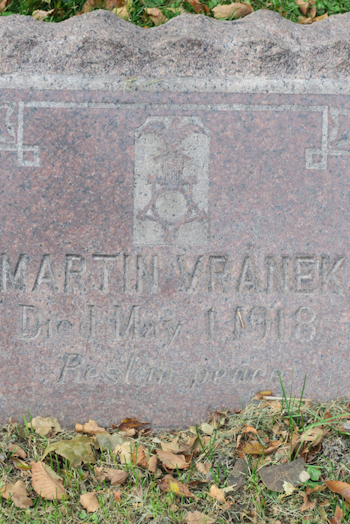
Martin Vranek (Martin Brock used in many military records)
November 20, 1845 Bohemia
May 1, 1918 Chicago
Lot 36 Block 1 Section Z
Company C 113th Illinois Volunteer Infantry Entered Service 8-13-1862 Mustered in October 1, 1862, Mustered out June 20, 1865 at Memphis, Tennessee.
Pension: Company C 113th Illinois Infantry
DH Obit: Martin, Vranek 2, May 1918
Find A Grave: # 38962169
Military Headstone: No
Photo Left - Click Here For Larger Image
Photo Right - Click Here For Larger Image
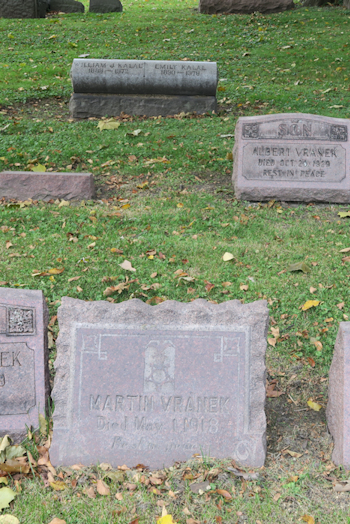

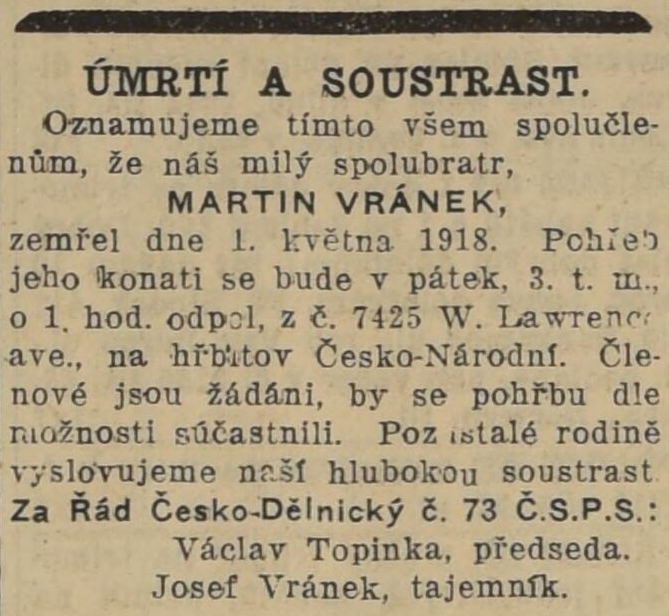
NOTE: Many records use the name Martin Brock, mostly military, but also the 1922 and 1929 Roll of Honor for Bohemian National Cemetery.
Martin Vranek was mustered into Company C or the 113th Illinois Volunteer Infantry, as Martin Brock, on October 1, 1862. The unit conducted organization and then training at Camp Douglas in Chicago. The web site, www.illinoiscivilwar.org, mentions that this regiment was also described as the “Third Chicago Board of Trade Regiment.[i] The 113th Illinois Infantry was involved in military campaigns in Tennessee and Mississippi. The major engagements were around Memphis and Vicksburg. The unit was mustered out on June 20 to 25, 1865, in Chicago.
Click Here To View Pension Record 1
Click Here to View Pension Record 2
Click Here to View Roster of Company C, 113th Infantry Regiment
Click Here to View History of 113th Infantry Regiment during the Civil War
Martin married Elizabeth Cesal May 4, 1869 at Saint Wenceslaus Catholic Church in Chicago. One of the witnesses listed was a Frank Vranek. Click Here To View Marriage Record
A Find A Grave contributor has created a virtual cemetery for as many Civil War Veterans from Company C as he can find. It is https://www.findagrave.com/virtual-cemetery/96380?page=1#sr-21590901
[i] http://www.illinoiscivilwar.org/cw113-hist.html
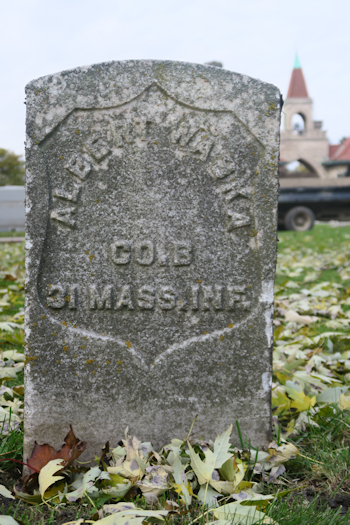
Albert (Vojtech) Vaska (Waska)
Lot 1 Block 1 Section K
April 4, 1840 Svihov #156, Bohemia
October 29, 1878 Chicago
Private Company B 31st Massachusetts Infantry “Western Bay Regiment”
Mustered in July 4, 1862 Mustered out July 7, 1865 Mobile, Alabama
Pension 31st Massachusetts Infantry
DH Obit: No
Find A Grave #95111187
Military Headstone: Yes
Photo Left - Click Here For A Larger Image
Photo Right - Click Here For A Larger Image
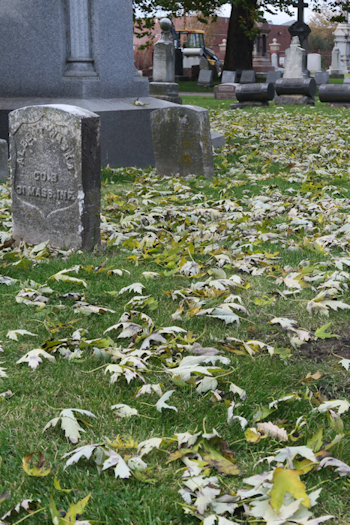
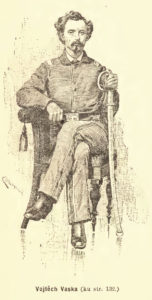 The 31st Massachusetts Infantry was the first Union military unit to enter New Orleans. Most of their battlefield activities were in Louisiana. (Click Here To View Albert's records with the 31st Massachusetts Infantry) There is a very good website which provides the history of the 31st Massachusetts - https://31massinf.wordpress.com/
The 31st Massachusetts Infantry was the first Union military unit to enter New Orleans. Most of their battlefield activities were in Louisiana. (Click Here To View Albert's records with the 31st Massachusetts Infantry) There is a very good website which provides the history of the 31st Massachusetts - https://31massinf.wordpress.com/
Albert Waska was born on April 4, 1840 in Svihov #156. (Click Here To View Birth Record) Albert Waska was already in Chicago in 1867, listed in the city directory at 204 S. Clinton and working as a bartender.
All Chicago Directory listings for Albert Vaska, from 1867 to 1876, list Albert’s occupation as a bartender or saloon owner.
Albert Waska married Maria Korba on April 14, 1868 (Click Here To View Marriage Record) at Saint Wenceslaus Catholic Church in Chicago.[i]
There is only the 1870 census record for Albert, listed as Albert and Mary Worka, with daughter Mary age 2.[ii]
The military headstone for Albert was ordered by Joseph Vaska (Waska). (Click Here To View HS Request) Joseph was Albert’s brother. Joseph, several siblings, and parents; Prokop and Anna arrived in Baltimore, aboard the ship Geestemunde on June 14, 1862 with the spelling of Washka. Joseph lived in Chicago and died in 1938 from an auto accident. Albert’s wife’s Korba family also arrived on the Geestemunde. Albert’s wife Mary died in 1937. Albert’s sister, Katherine Waska Haisman and her family arrived in 1860. Albert’s brother, John Waska and his family arrived in 1866. They are all also buried in Bohemian National Cemetery along with Albert’s family and his parents.
[i] "Illinois, Chicago, Catholic Church Records, 1833-1925," database with images, FamilySearch (https://familysearch.org/ark:/61903/3:1:S3HT-DWY3-9XS?cc=1452409&wc=M66P-Y68%3A40444701%2C40662101 : 20 May 2014), St Wenceslaus Parish (Chicago: DeKoven St) > Marriages 1866-1870 > image 9 of 24; Catholic Church parishes, Chicago Diocese, Chicago.
[ii] "United States Census, 1870," database with images, FamilySearch (https://familysearch.org/ark:/61903/1:1:M645-M56 : 12 April 2016), Albert Worka, Illinois, United States; citing p. 80, family 665, NARA microfilm publication M593 (Washington D.C.: National Archives and Records Administration, n.d.); FHL microfilm 545,703.
A history of the Czechs in Chicago, Collected and Organized by Rudolf Bubenicek. Translated by Karleen Chott Sheppard CSAGSI, Chicago, Illinois, 1939. Privately printed. Typesetting by West Side Press. Printed and bound by R. Mejdrich and Company.
